The effects of dexmedetomidine on cardiac electrophysiology in children2008
- 格式:pdf
- 大小:119.32 KB
- 文档页数:5
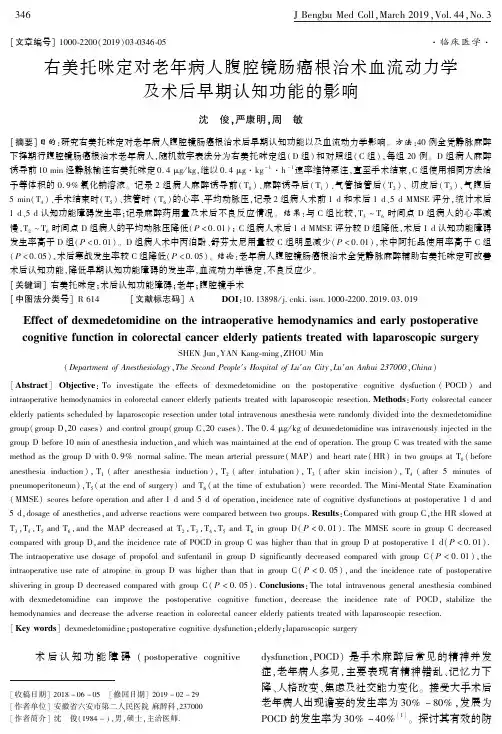
[收稿日期]2018-06-05 [修回日期]2019-02-29[作者单位]安徽省六安市第二人民医院麻醉科,237000[作者简介]沈 俊(1984-),男,硕士,主治医师.[文章编号]1000⁃2200(2019)03⁃0346⁃05㊃临床医学㊃右美托咪定对老年病人腹腔镜肠癌根治术血流动力学及术后早期认知功能的影响沈 俊,严康明,周 敏[摘要]目的:研究右美托咪定对老年病人腹腔镜肠癌根治术后早期认知功能以及血流动力学影响㊂方法:40例全凭静脉麻醉下择期行腹腔镜肠癌根治术老年病人,随机数字表法分为右美托咪定组(D 组)和对照组(C 组),每组20例㊂D 组病人麻醉诱导前10min 经静脉输注右美托咪定0.4μg /kg,继以0.4μg㊃kg -1㊃h -1速率维持泵注,直至手术结束,C 组使用相同方法给予等体积的0.9%氯化钠溶液㊂记录2组病人麻醉诱导前(T 0)㊁麻醉诱导后(T 1)㊁气管插管后(T 2)㊁切皮后(T 3)㊁气腹后5min(T 4)㊁手术结束时(T 5)㊁拔管时(T 6)的心率㊁平均动脉压,记录2组病人术前1d 和术后1d㊁5d MMSE 评分,统计术后1d㊁5d 认知功能障碍发生率;记录麻醉药用量及术后不良反应情况㊂结果:与C 组比较,T 3~T 6时间点D 组病人的心率减慢,T 2~T 6时间点D 组病人的平均动脉压降低(P <0.01);C 组病人术后1d MMSE 评分较D 组降低,术后1d 认知功能障碍发生率高于D 组(P <0.01)㊂D 组病人术中丙泊酚㊁舒芬太尼用量较C 组明显减少(P <0.01),术中阿托品使用率高于C 组(P <0.05),术后寒战发生率较C 组降低(P <0.05)㊂结论:老年病人腹腔镜肠癌根治术全凭静脉麻醉辅助右美托咪定可改善术后认知功能,降低早期认知功能障碍的发生率,血流动力学稳定,不良反应少㊂[关键词]右美托咪定;术后认知功能障碍;老年;腹腔镜手术[中图法分类号]R 614 [文献标志码]A DOI :10.13898/ki.issn.1000⁃2200.2019.03.019Effect of dexmedetomidine on the intraoperative hemodynamics and early postoperative cognitive function in colorectal cancer elderly patients treated with laparoscopic surgerySHEN Jun,YAN Kang⁃ming,ZHOU Min(Department of Anesthesiology ,The Second People′s Hospital of Lu′an City ,Lu′an Anhui 237000,China )[Abstract ]Objective :To investigate the effects of dexmedetomidine on the postoperative cognitive dysfuction (POCD )and intraoperative hemodynamics in colorectal cancer elderly patients treated with laparoscopic resection.Methods :Forty colorectal cancer elderly patients scheduled by laparoscopic resection under total intravenous anesthesia were randomly divided into the dexmedetomidine group(group D,20cases)and control group(group C,20cases).The 0.4μg /kg of dexmedetomidine was intravenously injected in the group D before 10min of anesthesia induction,and which was maintained at the end of operation.The group C was treated with the same method as the group D with 0.9%normal saline.The mean arterial pressure(MAP)and heart rate(HR)in two groups at T 0(before anesthesia induction ),T 1(after anesthesia induction ),T 2(after intubation ),T 3(after skin incision ),T 4(after 5minutes of pneumoperitoneum),T 5(at the end of surgery)and T 6(at the time of extubation)were recorded.The Mini⁃Mental State Examination (MMSE)scores before operation and after 1d and 5d of operation,incidence rate of cognitive dysfunctions at postoperative 1d and 5d,dosage of anesthetics,and adverse reactions were compared between two groups.Results :Compared with group C,the HR slowed at T 3,T 4,T 5and T 6,and the MAP decreased at T 2,T 3,T 4,T 5and T 6in group D(P <0.01).The MMSE score in group C decreased compared with group D,and the incidence rate of POCD in group C was higher than that in group D at postoperative 1d(P <0.01).The intraoperative use dosage of propofol and sufentanil in group D significantly decreased compared with group C(P <0.01),the intraoperative use rate of atropine in group D was higher than that in group C(P <0.05),and the incidence rate of postoperative shivering in group D decreased compared with group C(P <0.05).Conclusions :The total intravenous general anesthesia combinedwith dexmedetomidine can improve the postoperative cognitive function,decrease the incidence rate of POCD,stabilize the hemodynamics and decrease the adverse reaction in colorectal cancer elderly patients treated with laparoscopic resection.[Key words ]dexmedetomidine;postoperative cognitive dysfunction;elderly;laparoscopic surgery 术后认知功能障碍(postoperative cognitivedysfunction,POCD)是手术麻醉后常见的精神并发症,老年病人多见,主要表现有精神错乱㊁记忆力下降㊁人格改变㊁焦虑及社交能力变化㊂接受大手术后老年病人出现谵妄的发生率为30%~80%,发展为POCD 的发生率为30%~40%[1]㊂探讨其有效的防治措施,意义重大㊂右美托咪啶(dexmedetomidine, Dex)是一种新型㊁高选择性α2肾上腺素受体激动剂,具有镇静催眠㊁抗焦虑㊁降低应激反应㊁抗寒战等作用㊂在Dex对改善老年病人全身麻醉POCD的Meta分析中发现,Dex可降低老年病人POCD发生率,改善简易智力状态检查量表(mini⁃mental state examination,MMSE)评分[2]㊂DEINER等[3]发现,在进行年龄和教育水平因素校正后,非心脏大手术中输注0.5μg㊃kg-1㊃h-1Dex,术后3个月和6个月的认知功能表现与对照组并无明显差异㊂杨悦等[4]证实,老年病人开腹结直肠癌根治术中持续泵入0.4μg㊃kg-1㊃h-1Dex,术中血流动力学更加平稳,腹腔镜手术的刺激更强,长时间气腹后会导致脑组织氧耗增加,脑氧代谢供需失衡,可能会诱发POCD[5]㊂Dex对老年病人腹腔镜下肠癌根治术中的血流动力学是否有同样的效应以及能否减少POCD发生值得探讨㊂本研究探讨老年病人腹腔镜肠癌根治术中应用Dex对术中血流动力学以及术后认知功能的影响,现作报道㊂1 资料与方法1.1 一般资料 选择我院2015年7月至2017年12月择期行腹腔镜肠癌根治术的老年病人40例, ASAⅡ~Ⅲ级,年龄61~81岁,性别不限㊂纳入标准:能积极配合调查;无视听障碍,无酗酒及药物滥用史,无肝肾功能障碍,无精神性疾病;术前未服用镇静药及抗抑郁药;术前MMSE评分:未受教育者≥17分,小学≥20分,中学≥22分,大学≥24分[6]㊂40例病人按随机数字表分为右美托咪定组(D组)和对照组(C组),每组20例㊂1.2 麻醉方法 病人入室后开放外周静脉通路,监测无创血压㊁心率(HR)㊁心电图㊁血氧饱和度㊁呼吸频率及体温㊂麻醉诱导:静脉注射咪达唑仑0.04mg/kg㊁舒芬太尼0.2~0.5μg/kg㊁丙泊酚1.2~1.8mg/kg㊁罗库溴铵0.6mg/kg㊂待睫毛反射消失㊁肌肉松弛后气管插管机械通气,潮气量8~10mL/kg,吸呼比1∶2,通气频率10~16次/分,FiO2 100%,维持呼气末二氧化碳分压35~45mmHg㊂麻醉维持:静脉泵注丙泊酚4~6mg㊃kg-1㊃h-1,间断追加舒芬太尼以及罗库溴铵㊂术中维持HR50~ 100次/分,HR<50次/分静脉注射阿托品0.25~ 0.5mg,HR>100次/分静脉注射艾司洛尔10~ 20mg㊂收缩压小于基础值的20%时加快输液速度,必要时静脉注射麻黄碱5~10mg;收缩压大于基础值的30%时静脉注射尼卡地平0.1~0.2mg㊂术后病人均行静脉病人自控镇痛,舒芬太尼2μg/ kg加0.9%氯化钠溶液至100mL,背景输注速率2mL/h,单次给药剂量0.5mL,锁定时间15min,维持疼痛视觉模拟评分(VAS)<3分㊂D组病人在诱导前10min经静脉输注右美托咪定0.4μg/kg,继以0.4μg㊃kg-1㊃h-1维持输注至手术结束;C组使用相同方法给予等体积的0.9%氯化钠溶液㊂1.3 观察指标 本研究麻醉的实施与MMSE评测均采用双盲法,记录2组病人术前1d㊁术后1d㊁术后5d MMSE评分,由未参与麻醉实施的同一名研究人员测定,统计术后1d㊁术后5d2组病人POCD 发生率㊂POCD诊断标准:术后MMSE评分低于术前基础值2分及2分以上[7]㊂记录麻醉诱导前(T0)㊁麻醉诱导后(T1)㊁气管插管后(T2)㊁切皮后(T3)㊁气腹后5min(T4)㊁手术结束时(T5)㊁拔管时(T6)的HR以及平均动脉压(MAP),记录术中丙泊酚及舒芬太尼用量及血管活性药物的使用情况,苏醒时间(术毕至病人定向力恢复时间)㊁术毕48h内恶心呕吐㊁寒战发生例数㊂1.4 统计学方法 采用t检验㊁方差分析㊁q检验及χ2检验㊂2 结果2.1 2组病人一般资料比较 2组病人年龄㊁性别㊁ASA分级㊁身高㊁手术时间㊁受教育年限比较差异均无统计学意义(P>0.05)(见表1)㊂表1 2组病人一般资料的比较(x±s)分组n男女年龄/岁ASA分级 Ⅱ Ⅲ 身高/cm体质量/kg受教育年限/年手术时间/minD组2012872±9317167.4±9.152.5±8.97.95±2.32173±42 C组2013770±9515165.8±8.355.6±7.68.35±2.56180±48 t 0.11△0.700.65△0.58 1.180.510.49 P >0.05>0.05>0.05>0.05>0.05>0.05>0.05 △示χ2值2.2 2组病人不同时点血流动力学及血管活性药物使用率比较 与C组比较,T3~T6时间点D组病人的HR减慢,T2~T6时间点D组病人的MAP降低(P<0.01);T1时间点2组病人MAP均较T0时降低(P<0.01)㊂D组术中阿托品使用率高于C组,C 组术中艾司洛尔㊁尼卡地平使用率均高于D组(P<0.05)(见表2㊁3)㊂表2 2组病人术中不同时点血流动力学比较(n i=20;x±s)分组T0T1T2T3T4T5T6F P MS组内HR/(次/分) D组78±1069±8△80±1169±8△66±7△△66±8△△70±8△△8.38<0.0175.143 C组76±970±982±1278±983±1179±780±9 4.15<0.0191.143 t0.660.370.55 3.34 5.83 5.47 3.71 P>0.05>0.05>0.05<0.01<0.01<0.01<0.01 MAP/mmHg D组102±1186±14△△100±1682±12△△90±14△85±13△△105±129.84<0.01175.143 C组108±1287±17△△120±23102±11117±15115±10120±1911.49<0.01252.714 t 1.650.20 3.19 5.49 5.888.18 2.99 P>0.05>0.05<0.01<0.01<0.01<0.01<0.01 q检验:与T0时比较△P<0.05,△△P<0.01表3 2组病人血管活性药物使用率比较[n;百分率(%)]分组n阿托品麻黄碱艾司洛尔尼卡地平D组208(40.0)2(10.0)1(5.0)2(10.0)C组202(10.0)3(15.0)7(35.0)9(45.0)合计4010(25.0)5(12.5)8(20.0)11(27.5)χ2 4.800.00 3.91 4.51P <0.05>0.05<0.05<0.05 2.3 2组病人MMSE评分及POCD发生率比较 C组病人术后1d MMSE评分较术前1d降低(P< 0.05);与D组病人比较,C组病人术后1d MMSE 评分降低,差异有统计学意义(P<0.01);与D组比较,C组病人术后1d POCD发生率升高(P< 0.05);2组病人术后5d POCD发生率差异无统计学意义(P>0.05)(见表4㊁5)㊂表4 2组病人手术前后MMSE评分比较(x±s;分)分组n术前1d术后1d术后5d F P MS组内D组2027.65±1.4527.26±1.3827.37±1.560.38>0.052.147 C组2027.35±1.5325.79±1.84△26.89±1.78 4.33<0.052.965 t 0.64 2.860.91 P >0.05<0.01>0.05 q检验:与术前1d比较△P<0.052.4 2组病人麻醉药物用量及术后苏醒时间比较 与C组病人比较,D组病人术中丙泊酚㊁舒芬太尼用量明显减少(P<0.01),2组病人术后苏醒时间差异无统计学意义(P>0.05)(见表6)㊂表5 2组病人术后POCD发生率比较[n;百分率(%)]分组n术后1d术后5dD组201(5.0)0(0.0)C组207(35.0)2(10.0)合计408(20.0)2(5.0)χ2 3.91P <0.05>0.05表6 2组病人麻醉药物用量及术后苏醒时间比较(x±s)分组n丙泊酚用量/mg舒芬太尼用量/μg苏醒时间/min D组201187±85 53±712.9±4.2 C组201324±10565±912.6±3.9t 4.535 4.7070.234P <0.01<0.01>0.05 2.5 2组病人不良反应发生情况比较 D组病人术后寒战发生率低于C组(P<0.05),2组病人恶心㊁呕吐不良反应发生情况差异无统计学意义(P> 0.05)(见表7)㊂3 讨论 Dex的药理特性表现为如果不使用负荷量,起效较慢,负荷剂量过大导致HR减慢及血压升高㊂有学者[8]在腹腔镜胆囊切除术使用负荷量1μg/ kg Dex,术中维持输注0.4μg㊃kg-1㊃h-1至手术结束,结果发现可降低老年病人早期POCD发生率;表7 2组病人不良反应发生情况比较[n;百分率(%)]分组n恶心㊁呕吐 寒战D组202(10.0)0(0.0)C组203(15.0)5(25.0)合计405(12.5)5(12.5)χ2 0.00P >0.05<0.05汤莉莉等[9]对脆弱脑功能老年病人使用Dex负荷量0.4μg/kg,术中维持输注0.4μg㊃kg-1㊃h-1至手术结束前30min,病人术后谵妄发生率减少㊂本研究参照上述研究结合老年病人对药物的敏感性增加,采用Dex负荷量0.4μg/kg静脉输注,维持速率0.4μg㊃kg-1㊃h-1输注直至手术结束㊂本研究结果表明,C组病人术后1d MMSE评分低于D组病人,术后1d POCD发生率高于D组病人(P<0.05),说明Dex可降低老年病人腹腔镜手术后早期POCD发生率,减轻老年病人术后认知功能损害,可能与Dex对动物具有学习记忆㊁神经保护作用有关[10-11]㊂LI等[8]对老年病人腹腔镜胆囊切除术后认知功能的研究,同样发现Dex可降低病人早期POCD的发生㊂本研究显示,2组病人术后5 d MMSE评分㊁POCD发生率无明显差异,而XU 等[12]使用蒙特利尔认知评估量表(Montreal Cognitive Assessment,MoCA)评分观察Dex对老年病人腹腔镜卵巢囊肿切除术后认知功能的影响,发现术后7d Dex组的POCD发生率明显低于对照组㊂不同的表现可能与MMSE评分法的缺陷有关, MMSE评分法操作简单,耗时短,受试者接受度较高,对中重度和多个认识领域受损敏感度高,但与MoCA评分相比,其记忆力的测试过于简单,非语言项目少,对单个认知领域受损的敏感性不高,尤其是对于教育程度较高的病人,容易掩盖POCD[13]㊂腹腔镜手术由于气腹的强刺激和特殊体位,激活交感神经,导致气腹后HR和血压大幅升高,本研究结果表明,D组病人在气管插管后以及气腹后等强刺激时点的HR与MAP优于C组,且C组尼卡地平及艾司洛尔使用率高于D组,反映出Dex能够抑制术中的不良心血管反应,血流动力学更加平稳㊂我们发现D组病人阿托品使用例数多于C组,尤其是在负荷量输注阶段,需要使用阿托品纠正,可能与初始静注Dex导致的反射性HR减慢有关[14]㊂有研究[15]发现与可乐定㊁β受体阻滞剂以及阿片类药物相比较,Dex能够更有效降低腹腔镜手术的应激效应㊂D组病人术中的丙泊酚㊁舒芬太尼用量较C组病人明显减少,阿片类药物以及静脉麻醉药使用量增加是术后谵妄的高危因素且与它们的剂量呈正相关[16]㊂2组病人术后苏醒时间差异无统计学意义,说明Dex镇静同时并不延长苏醒时间;此外2组病人术后恶心㊁呕吐发生率差异亦无统计学意义,研究[17]发现,Dex有利于术后胃肠道运动能力恢复,缩短肠道通气时间;D组病人术后寒战发生例数少于C组,说明Dex在减少老年病人术后认知功能损害同时,使病人更加舒适㊂总之,Dex可降低老年病人腹腔镜肠癌手术早期POCD的发生,术中血流动力学稳定,不良反应少,病人舒适安全㊂[参考文献][1] DECRANE SK,SANDS L,ASHLAND M,et al.Factors associatedwith recovery from early postoperative delirium[J].J PerianesthNurs,2011,26(4):231.[2] XY G,LI LL,SUN ZT,et al.Effect of dexmedetomidine onpostoperative cognit⁃ive dysfunction in elderly patients aftergeneral anaesthesia:a meta⁃analysis[J].J Inter Med Res,2016,44(6):1182.[3] DEINER S,LUO X,LIN HM,et al.Intraoperative infusion ofdexmedetomidine for prevention of postoperative delirium andcognitive dysfunction in elderly patients undergoing major electivenoncardiac surgery:a randomized clinical trial[J].JAMA Surg,2017,152(8):e171505.[4] 杨悦,马铃,代玉婷,等.盐酸右美托咪定对开腹结直肠癌根治术患者围术期肺动态顺应性和外周血中TLR⁃2和TLR⁃4表达的影响[J].中国医科大学学报,2016,45(12):1077. [5] 周翔,吴明春,宋晓阳,等.长时间后腹腔镜手术对脑氧供需平衡的影响[J].重庆医学,2012,41(3):260.[6] 李兴,闻大翔,陈杰,等.老年患者术后认知功能障碍发生率及相关因素的多中心研究[J].临床麻醉学杂志,2009,25(8):652.[7] BEKKER AY,WEEKS EJ.Cognitive function after anaesthesia inthe elderly[J].Best Practice Res Clin Anaesthesial,2003,17(2):259.[8] LI Y,HE R,CHEN S,et al.Effect of dexmedetomidine on earlypostoperative cognitive dysfunction and peri⁃operative inflammationin elderly patients undergoing laparoscopic cholecystectomy[J].Exp Ther Med,2015,10(5):1635.[9] 汤莉莉,顾尔伟,张雷,等.右美托咪定对老年脆弱脑功能患者术后认知功能的影响[J].中华麻醉学杂志,2016,36(2):140.[10] CARLA NC,CHRISTIANE CS,LOUISE LC,et al.Perturbation ofion channel conductance alters the hypnotic response to theɑ2⁃adrenergic agonist dexmedetomidine in the locus coeruleus of therat[J].Anesthesiology,1994,81(4):1527.(下转第352页)一个稳定且便于检测的观察指标㊂有学者[11]认为,人类精子的DNA损伤与8⁃OHdG的生成密切相关㊂8⁃OHdG是人类DNA分子中鸟嘌呤碱基的第8位C原子在过量的ROS攻击下发生变异后,结合⁃OH而产生的一种氧化性加合物㊂它可以在8⁃羟基鸟嘌呤DNA糖苷酶的作用下,通过一些保护机制,如碱基及核苷酸的切除修复等,从DNA双链上被切除,从而生成游离的8⁃OHdG,更易被检测到㊂在目前已知的大约20种DNA氧化产物中,其半衰期最长达55min,生成量相对较高且非常稳定,而且不受饮食等因素的影响,检测方法也较为灵敏,是目前学术界公认的衡量氧化应激及DNA损伤的可靠指标㊂有研究[12]显示,8⁃OHdG水平与DNA损伤程度呈正相关关系㊂8⁃OHdG在病人的血㊁尿㊁精液及睾丸组织中均有表达,且8⁃OHdG在VC病人的血清及精浆中含量明显高于正常人,临床上可以通过检测8⁃OHdG的水平来判断VC病人的严重程度,为VC病人不育的诊疗提供帮助㊂本研究通过检测不同病理状态VC病人血清中8⁃OHdG的含量,并进行术前与术后的对比分析㊂研究结果显示,VC病人在行精索静脉高位结扎术后的血清8⁃OHdG水平明显低于术前(P<0.01)㊂8⁃OHdG水平的降低表明术后VC病人体内氧化应激水平降低,由此造成的DNA损伤也降低,从侧面反映了精索静脉高位结扎术治疗的有效性,也为手术后疗效的评价提供了新的依据㊂我们进而猜测,若结合精浆㊁尿液及睾丸组织中的8⁃OHdG水平对比分析,可能会为临床治疗提供新的思路㊂但在本研究中对于临床型及亚临床型的VC病人未加以区分细化,其8⁃OHdG的水平是否有差异尚未可知,在以后的研究中,8⁃OHdG很可能为亚临床型的病人提供术前诊断的依据㊂[参考文献][1] BIYANI CS,JANETSCHEK G.Varicocele[J].Clin Evid,2005(13):1142.[2] GARCÍA⁃PEIRÓA,RIBAS⁃MAYNOU J,OLIVER⁃BONET M,etal.Multiple determinations of sperm DNA fragmentation show thatvaricocelectomy is not indicated for infertile patients withsubclinical varicocele[J].Biomed Res Int,2014,2014:181396.[3] 潘洪志,李蓉.DNA氧化损伤标志物8⁃羟基脱氧鸟苷及其检测[J].中国卫生检验杂志,2003,13(4),404.[4] KOLON TF.Evaluation and management of the adolescentvaricocele[J].J Urol,2015,194(5):1194.[5] 江芳,叶卓明,郑厚斌,等.精索静脉曲张不育患者8⁃羟基脱氧鸟苷水平的检测分析[J].中国计划生育学杂志,2013,21(6):391.[6] MOSTAFA T,RASHED LA,NABIL N,et al.Endothelial nitric oxidesynthase gene polymorphism relationship with semen parameters andoxidative stress in infertile oligoasthenoteratozoospermic men[J].Urology,2015,85(5):1058.[7] SEMENZA GL.Oxygen sensing,hypoxia⁃inducible factors,anddisease pathophysiology[J].Annu Rev Pathol,2014,9:47. [8] 符浩,宋汶珂,凌晓辉,等.精索静脉曲张不育患者氧化应激水平和精子DNA完整性及精液参数的相关性分析[J].中华男科学杂志,2016,22(6):530.[9] 陈云斌.精索静脉曲张与雄性激素水平的相关性研究[D].南宁:广西医科大学,2013.[10] 史秋华,李沙沙,王磊.精索静脉高位结扎术联合抗氧化剂治疗对精索静脉曲张不育症患者精液质量的影响[J].中国继续医学教育,2016,25(26):110.[11] 杨文涛,李群生,周磊,等.广西中医㊁中西医结合男科学术大会㊁全国中西医结合男科疾病诊疗新进展学习班班论文集[C].中国中西医结合学会男科专业委员会,2015:1.[12] GUO Z,LIU X,LIU Y,et al.Constructing a novel8⁃hydroxy⁃2′⁃deoxyguanosine electrochemical sensor and application inevaluating the oxidative damages of DNA and guanine[J].Biosens Bioelectron,2016,86:671.(本文编辑 周洋)(上接第349页)[11] 杨俊杰,陈玉军,于亮,等.右美托咪啶对创伤性脑损伤大鼠模型的神经保护作用实验研究[J].国际神经病学神经外科学杂志,2017,44(5):523.[12] XU HY,FU GH,WU GS.Effect of dexmedetomidine⁃inducedanesthesia on the postoperative cognitive function of elder patientsafter laparoscopic ovarian cystectomy[J].Saudi J Biol Sci,2017,24(8):1771.[13] TRZEPACZ PT,HOCHSTETLER H,WANG S,et al.Relationshipbetween the Montreal Cognitive Assessment and Mini⁃mental StateExamination for assessment of mild cognitive impairment in olderadults[J].BMC Geriatr,2015,15:107.[14] KO KH,JUN IJ,LEE S,et al.Effective dose of dexmedetomi dineto induce adequate sedation in elderly patients under spinalanesthesia[J].Korean J Anesthesiol,2015,68(6):575. [15] SHAMIM R,SRIVASTAVA S,RASTOGI A,et al.Effect of twodifferent doses of Dexmedetomidine on stress response inlaparoscopic pyeloplasty:a randomized prospective controlledstudy[J].Anesth Essays Res,2017,11(4):1030. [16] INOUYE SK,WESTENDROP RG,SACZYNSKI JS.Delirium inelderly people[J].Lancet,2014,383(9920):911. [17] CHEN C,HUANG P,LAI L,et al.Dexmedetomidine improvesgastrointestinal motility after laparoscopic resection of colorectalcancer:a randomized clinical trial[J].Medicine,2016,95(29):e4295.(本文编辑 周洋)。
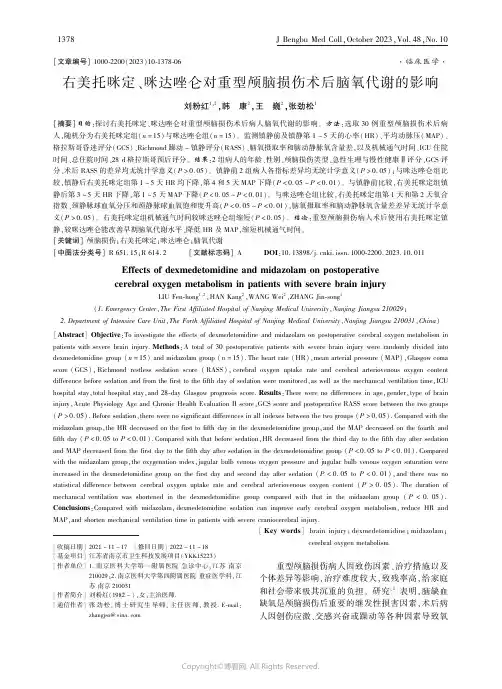
[收稿日期]2021-11-17 [修回日期]2022-11-18[基金项目]江苏省南京市卫生科技发展项目(YKK15223)[作者单位]1.南京医科大学第一附属医院急诊中心,江苏南京210029;2.南京医科大学第四附属医院重症医学科,江苏南京210031[作者简介]刘粉红(1982-),女,主治医师.[通信作者]张劲松,博士研究生导师,主任医师,教授.E⁃mail:zhangjso@[文章编号]1000⁃2200(2023)10⁃1378⁃06㊃临床医学㊃右美托咪定㊁咪达唑仑对重型颅脑损伤术后脑氧代谢的影响刘粉红1,2,韩 康2,王 巍2,张劲松1[摘要]目的:探讨右美托咪定㊁咪达唑仑对重型颅脑损伤术后病人脑氧代谢的影响㊂方法:选取30例重型颅脑损伤术后病人,随机分为右美托咪定组(n =15)与咪达唑仑组(n =15)㊂监测镇静前及镇静第1~5天的心率(HR)㊁平均动脉压(MAP)㊁格拉斯哥昏迷评分(GCS)㊁Richmond 躁动-镇静评分(RASS)㊁脑氧摄取率和脑动静脉氧含量差,以及机械通气时间㊁ICU 住院时间㊁总住院时间㊁28d 格拉斯哥预后评分㊂结果:2组病人的年龄㊁性别㊁颅脑损伤类型㊁急性生理与慢性健康Ⅱ评分㊁GCS 评分㊁术后RASS 的差异均无统计学意义(P >0.05)㊂镇静前2组病人各指标差异均无统计学意义(P >0.05);与咪达唑仑组比较,镇静后右美托咪定组第1~5天HR 均下降,第4和5天MAP 下降(P <0.05~P <0.01)㊂与镇静前比较,右美托咪定组镇静后第3~5天HR 下降,第1~5天MAP 下降(P <0.05~P <0.01)㊂与咪达唑仑组比较,右美托咪定组第1天和第2天氧合指数㊁颈静脉球血氧分压和颈静脉球血氧饱和度升高(P <0.05~P <0.01),脑氧摄取率和脑动静脉氧含量差差异无统计学意义(P >0.05)㊂右美托咪定组机械通气时间较咪达唑仑组缩短(P <0.05)㊂结论:重型颅脑损伤病人术后使用右美托咪定镇静,较咪达唑仑能改善早期脑氧代谢水平㊁降低HR 及MAP,缩短机械通气时间㊂[关键词]颅脑损伤;右美托咪定;咪达唑仑;脑氧代谢[中图法分类号]R 651.15;R 614.2 [文献标志码]A DOI :10.13898/ki.issn.1000⁃2200.2023.10.011Effects of dexmedetomidine and midazolam on postoperativecerebral oxygen metabolism in patients with severe brain injuryLIU Fen⁃hong 1,2,HAN Kang 2,WANG Wei 2,ZHANG Jin⁃song 1(1.Emergency Center ,The First Affiliated Hospital of Nanjing Medical University ,Nanjing Jiangsu 210029;2.Department of Intensive Care Unit ,The Forth Affiliated Hospital of Nanjing Medical University ,Nanjing Jiangsu 210031,China )[Abstract ]Objective :To investigate the effects of dexmedetomidine and midazolam on postoperative cerebral oxygen metabolism in patients with severe brain injury.Methods :A total of 30postoperative patients with severe brain injury were randomly divided into dexmedetomidine group (n =15)and midazolam group (n =15).The heart rate (HR),mean arterial pressure (MAP),Glasgow coma score (GCS),Richmond restless sedation score (RASS),cerebral oxygen uptake rate and cerebral arteriovenous oxygen content difference before sedation and from the first to the fifth day of sedation were monitored,as well as the mechanical ventilation time,ICU hospital stay,total hospital stay,and 28⁃day Glasgow prognosis score.Results :There were no differences in age,gender,type of brain injury,Acute Physiology Age and Chronic Health Evaluation II score,GCS score and postoperative RASS score between the two groups (P >0.05).Before sedation,there were no significant differences in all indexes between the two groups (P >0.05).Compared with the midazolam group,the HR decreased on the first to fifth day in the dexmedetomidine group,and the MAP decreased on the fourth and fifth day (P <0.05to P <0.01).Compared with that before sedation,HR decreased from the third day to the fifth day after sedation and MAP decreased from the first day to the fifth day after sedation in the dexmedetomidine group (P <0.05to P <0.01).Compared with the midazolam group,the oxygenation index,jugular bulb venous oxygen pressure and jugular bulb venous oxygen saturation were increased in the dexmedetomidine group on the first day and second day after sedation (P <0.05to P <0.01),and there was no statistical difference between cerebral oxygen uptake rate and cerebral arteriovenous oxygen content (P >0.05).The duration of mechanical ventilation was shortened in the dexmedetomidine group compared with that in the midazolam group (P <0.05).Conclusions :Compared with midazolam,dexmedetomidine sedation can improve early cerebral oxygen metabolism,reduce HR andMAP,and shorten mechanical ventilation time in patients with severe craniocerebral injury. [Key words ]brain injury;dexmedetomidine;midazolam; cerebral oxygen metabolism 重型颅脑损伤病人因致伤因素㊁治疗措施以及个体差异等影响,治疗难度较大,致残率高,给家庭和社会带来极其沉重的负担㊂研究[1]表明,脑缺血缺氧是颅脑损伤后重要的继发性损害因素,术后病人因创伤应激㊁交感兴奋或躁动等各种因素导致氧耗增加,加重脑缺血缺氧㊂临床研究[2-3]已证实高血压脑出血病人可以从镇静中获益,但对于急性重型颅脑损伤病人使用镇静药物的高级别循证医学证据不多,且缺乏不同的镇静药物在改善脑氧代谢障碍治疗效果方面差异性的相关研究㊂故本研究通过随机对照方法,探讨右美托咪定和咪达唑仑对重型颅脑损伤病人术后脑氧代谢及血流动力学的影响㊂1 资料与方法1.1 一般资料 选取2018年1月至2020年9月江苏省南京医科大学第四附属医院重症医学科(ICU)收治的重型颅脑损伤术后病人作为研究对象,所有病人均经头颅CT检查确诊为脑内出血(硬膜下㊁硬膜外或脑实质内等)或脑挫裂伤㊂纳入标准:(1)年龄18~80岁;(2)格拉斯哥昏迷评分(GCS)为>3~8分;(3)有 颅内血肿清除+去骨瓣减压术”指征;(4)无严重的胸腹部损伤及其他脏器损伤㊂排除标准:(1)病人入ICU前存在心跳呼吸骤停行心肺脑复苏;(2)入ICU后24h内死亡;(3)再出血,需二次手术;(4)有肺部严重损伤致急性呼吸窘迫综合征病人,在机械通气情况下氧分压仍难以维持者[动脉血氧分压(PaO2)≤60mmHg];(5)术前存在窦性心动过缓㊂本研究共收集36例,剔除研究中病情恶化死亡4例,放弃治疗2例,最终30例完成治疗过程,采用随机数字表法,分为右美托咪定组和咪达唑仑组,各15例㊂1.2 方法 2组病人术后均给予常规治疗㊂具体步骤:头部抬高30°~45°;机械通气维持指脉氧饱和度(SpO2)≥90%;给予甘露醇㊁人血白蛋白㊁呋塞米等药物处理控制脑水肿;舒芬太尼0.1~0.2μg㊃kg-1㊃h-1静脉泵入镇痛;苯巴比妥钠注射液0.1g 肌内注射,每12h1次;肠内营养支持,维持水电解质及酸碱平衡㊂右美托咪定组在上述处理方案基础上使用盐酸右美托咪定注射液(四川国瑞药业有限责任公司,规格1mL∶0.1mg,国药准字H20143195),0.2mg加入0.9%氯化钠溶液配成20mL,微量泵静脉泵入0.2~1.0μg㊃kg-1㊃h-1㊂咪达唑仑组病人给予咪达唑仑注射液(江苏恩华药业股份有限公司,规格1mL∶5mg,国药准字H19990027),20mg加入0.9%氯化钠溶液配成20mL,微量泵持续静脉泵入0.05~0.1mg㊃kg-1㊃h-1㊂每隔4h采用Richmond躁动-镇静评分(RASS)评估镇静效果,目标镇静深度为-2至0分㊂1.3 观察指标 所有病人去枕仰卧,头部偏向左侧,常规消毒铺巾,局麻后,超声引导下,经皮颈内静脉逆行穿刺置入14号单腔中心静脉导管,超声定位使导管头端到达颈静脉球位置,用肝素+0.9%氯化钠溶液冲洗,套上肝素帽,通过此导管采集血液,每日做血气分析㊂采用多功能心电监护仪连续监测心率(HR)㊁血压(BP)㊁平均动脉压(MAP)㊂采集2组病人术后第1~5天的颈静脉球及桡动脉血液,使用美国贝克曼公司GEM3000型血气分析仪,检测脑氧代谢指标,包括颈静脉球血氧饱和度(SjvO2)㊁颈静脉球血氧分压(PjvO2),动脉血氧饱和度(SaO2)㊁PaO2㊁血红蛋白(Hb),计算脑氧摄取率(CEO2) (CEO2=SaO2-SjvO2)和脑动静脉氧含量差(AVDO2)[AVDO2=Hbx1.34(SaO2-SjvO2)+ 0.003(PaO2-PjvO2)]㊂记录病人入ICU的急性生理学与慢性健康状况评分Ⅱ(APACHEⅡ)㊁GCS评分㊁生命体征,术后第1~5天的病人24h均值HR 及MAP㊁GCS评分,镇静后Richmond躁动-镇静评分(RASS)及2组病人的机械通气时间㊁ICU住院时间㊁总住院时间㊁28d格拉斯哥预后评分(Glasgow Outcome Score,GOS)㊂1.4 统计学方法 采用t检验㊁Fisher′s确切概率法㊁方差分析和q检验㊂检验水准α=0.05㊂2 结果2.1 2组病人基线资料比较 2组病人的年龄㊁性别㊁颅脑损伤类型㊁APACHEⅡ评分㊁GCS评分差异均无统计学意义(P>0.05)(见表1)㊂表1 2组病人临床基线资料的比较(x±s)分组nGCS评分 4~5分 6~8分 男女年龄/岁颅脑损伤类型 脑出血 颅脑外伤 APACHEⅡ评分/分GCS评分/分右美托咪定组153126960.70±8.812320.20±3.54 6.40±1.28咪达唑仑组1521311463.71±14.411421.47±3.67 6.47±0.83 t 0.67 0.960.17 P >0.05*>0.05* >0.05>0.05*>0.05>0.05 *示Fisher′s确切概率法P值2.2 2组病人镇静前后各时间点临床参数比较 镇静前,2组病人各相关指标差异均无统计学意义(P>0.05);镇静后,2组病人RASS评分差异均无统计学意义(P>0.05);与咪达唑仑组比较,右美托咪定组第1~5天HR均较低,第4天和第5天MAP 较低,差异均有统计学意义(P<0.05~P<0.01)㊂与镇静前比较,右美托咪定组病人镇静后第3~5天HR水平下降,第1~5天MAP下降(P<0.05~P< 0.01);与镇静第1天比较,MAP第5天血压下降(P<0.05);2组病人镇静后GCS评分差异无统计学意义(P>0.05),与镇静第1天比较,右美托咪定组病人第4天GCS评分增高(P<0.05)㊂咪达唑仑组镇静前后及镇静后各时间点差异均无统计学意义(P>0.05)(见表2)㊂表2 2组病人镇静前后各时间点临床参数比较(x±s)分组n镇静前镇静第1天镇静第2天镇静第3天镇静第4天镇静第5天F P MS组内HR/(次/分) 右美托咪定组15101.47±15.7295.53±11.5891.80±17.2083.81±13.62*86.40±16.29*85.01±17.18* 3.02<0.05237.141 咪达唑仑组15105.27±18.56113.41±10.98108.27±14.53103.06±16.48102.93±14.41101.02±15.34 1.33>0.05231.814 t 0.63 3.38 2.56 3.76 2.75 2.46 P >0.05<0.01<0.05<0.01<0.05<0.05 MAP/mmHg 右美托咪定组15114.64±24.1498.29±15.85**91.20±13.02**86.73±12.88**85.78±12.27**81.31±9.77**#9.26<0.01235.872 咪达唑仑组15101.73±16.01101.36±11.9293.58±11.3393.89±13.6194.31±7.8593.56±12.52 1.54>0.05155.013 t 2.120.590.55 1.27 2.29 2.69 P >0.05>0.05>0.05>0.05<0.05<0.05 GCS评分/分 右美托咪定组15 6.40±1.287.20±1.467.67±1.657.87±1.768.40±2.10*8.20±2.41 2.41<0.053.322 咪达唑仑组15 6.47±0.837.20±1.207.13±1.627.40±1.767.60±1.877.47±2.11 1.06>0.052.295 t 0.180.00 1.020.88 1.25 1.00 P >0.05>0.05>0.05>0.05>0.05>0.05 RASS评分/分 右美托咪定组15 -1.40±0.49-1.13±0.83-0.80±0.46#-0.67±0.75#-0.40±0.61# 4.96<0.010.467 咪达唑仑组15 -1.60±0.50-1.47±0.71-1.60±0.60-1.33±1.11-1.07±1.30 1.11>0.050.674 t 1.00 1.16 3.29 2.20 2.47 P >0.05>0.05>0.05>0.05>0.05 q检验:与镇静前比较*P<0.05,**P<0.01;与镇静第1天比较#P<0.052.3 2组病人镇静后各时间点氧代谢参数比较 与咪达唑仑组比较,右美托咪定组镇静第1天和第2天PaO2/FiO2㊁PjvO2和SjvO2水平较高,差异均有统计学意义(P<0.05~P<0.01),CEO2和AVDO2差异无统计学意义(P>0.05)㊂与镇静第1天比较,咪达唑仑组PjvO2和SjvO2水平第3至5天升高,CEO2第5天升高,AVDO2第4和5天升高,差异均有统计学意义(P<0.05~P<0.01),右美托咪定组差异均无明显统计学(P>0.05)(见表3)㊂表3 2组病人镇静后各时间点氧代谢参数比较(x±s)分组n镇静第1天镇静第2天镇静第3天镇静第4天镇静第5天F P MS组内(PaO2/FiO2)/mmHg 右美托咪定组15286.50±66.26291.17±65.02278.33±63.63259.33±59.98276.83±84.580.47>0.054730.762 咪达唑仑组15231.83±49.93238.67±64.97232.33±35.16243.67±49.04233.33±57.140.13>0.053034.167 t 2.30 2.17 1.950.78 1.87 P <0.05<0.05>0.05>0.05>0.05 PjvO2/mmHg 右美托咪定组1529.40±4.0129.47±4.8129.80±6.0030.13±5.1931.80±4.150.55>0.0526.455 咪达唑仑组1525.26±1.8927.13±5.0328.73±3.79##29.60±3.30##31.40±3.71##5.25<0.0115.697续表3分组n镇静第1天镇静第2天镇静第3天镇静第4天镇静第5天F P MS组内 t 3.19 2.450.640.360.24 P <0.01<0.05>0.05>0.05>0.05 SjvO2/% 右美托咪定组1555.26±12.0156.47±9.6658.07±11.0356.27±8.2660.73±8.930.66>0.05103.735 咪达唑仑组1546.06±6.3650.33±10.2156.93±13.96##56.40±8.12##60.27±9.85##4.40<0.01110.853 t 2.28 2.270.32 0.040.14 P <0.05<0.05>0.05>0.05>0.05 CEO2/% 右美托咪定组1547.07±13.2542.67±9.3338.73±10.7641.67±7.9937.87±8.46 1.94>0.05102.690 咪达唑仑组1549.93±7.2944.33±15.3541.27±12.7440.93±7.9736.07±11.30##2.97<0.05131.301 t 0.700.570.710.240.56 P >0.05>0.05>0.05>0.05>0.05 AVDO2/(mL/L) 右美托咪定组1569.28±22.3262.10±20.2253.89±15.8556.36±14.5851.08±13.57 2.48>0.05306.034 咪达唑仑组1569.48±17.6859.28±17.1856.97±16.4656.48±13.99#48.89±14.98##2.79<0.05294.376 t 0.210.470.700.030.43 P >0.05>0.05>0.05>0.05>0.05 q检验:与镇静1d比较#P<0.05,##P<0.012.4 2组病人机械通气时间㊁ICU住院时间㊁总住院时间及GOS评分比较 右美托咪定组病人机械通气时间较咪达唑仑组缩短,差异有统计学意义(P<0.05);2组ICU住院时间㊁总住院时间以及28d GOS预后差异均无统计学意义(P>0.05)(见表4)㊂表4 2组病人相关临床指标及预后比较(x±s)分组n 机械通气时间/dICU住院时间/d总住院时间/dGOS预后/分右美托咪啶组15 5.87±1.8614.67±6.2120.47±9.53 3.13±1.02咪达唑仑组158.40±3.0713.87±4.4720.27±8.48 2.93±1.12 t 2.730.400.060.51P <0.05>0.05>0.05>0.05 3 讨论 颅脑损伤是由于头部受到直接或间接作用而导致的颅脑组织损伤,GCS<8分㊁伤后意识障碍持续时间超过24h以及创伤后记忆功能障碍7d以上者,可判定为重型颅脑损伤[4]㊂重型颅脑损伤术后病人意识障碍㊁呛咳反射减弱㊁留置人工气道,更容易发生呼吸功能障碍,当出现躁动㊁机械通气不适和人机对抗时,均会使病人循环波动㊁影响氧合㊁增加全身组织氧耗,导致不良预后㊂合理的镇静,能降低病人的全身氧耗㊁改善氧输送㊂临床研究[5]证实,颅脑损伤病人能从镇静镇痛中获益,但不同镇静药物机制不同,效果及获益也不尽相同㊂目前危重症病人常用的镇静药物种类较多,其中苯二氮卓类使用较为广泛,其代表为咪达唑仑,起效较快,但停药后苏醒时间相对较长,对呼吸有明显抑制作用[6],在重型颅脑损伤病人中使用有一定的局限性㊂右美托咪定是高选择性的α2肾上腺素能受体激动剂,主要作用在脑干的蓝斑核,激活上行去甲肾上腺素通路,通过镇静镇痛作用,避免了疼痛和烦躁等导致的交感活性亢进[7];同时通过快速激活外周血管上突触前膜的α2肾上腺素能受体,抑制钙离子进入神经末梢的钙通道,抑制神经突触后膜释放去甲肾上腺素,最终降低血中儿茶酚胺浓度,抑制交感神经系统活性,引起BP㊁HR的变化,改善缺血损伤和代谢异常[8-9]㊂本研究中右美托咪定组病人HR及MAP均较咪达唑仑组病人控制更为理想,说明右美托咪定能降低重型颅脑损伤术后病人的应激反应㊁下调异常增高的交感神经兴奋性㊁稳定生命体征㊂重型颅脑损伤病人通过监测颅内压和脑氧代谢指标,能及时纠正脑组织缺氧,有利于改善病人神经功能预后[10]㊂因此监测脑氧代谢情况,早期发现脑缺血缺氧㊁维持脑氧供需平衡是重型颅脑损伤病人治疗的重要环节㊂颈静脉球部血氧分压及血氧饱和度能准确反映脑氧水平,通过计算得出CEO2和AVDO2,反映脑对氧的摄取以及消耗程度,这些指标是目前公认的脑氧代谢指标,可以帮助早期诊断脑缺血缺氧状态[11]㊂颅脑创伤后病人第1天脑血流明显下降,伴随氧代谢下降㊂研究[12-13]表明,颅脑创伤术后病人12h SjvO2最低,48~72h逐步升高, AVDO2和CEO2逐渐下降,提示脑缺氧及脑灌注得到改善㊂本研究中2组病人术后PjvO2㊁SjvO2变化趋势与上述结果一致㊂但右美托咪定组病人在术后第1天和第2天的PaO2/FiO2较咪达唑仑组明显升高,提示右美托咪定较咪达唑仑更能早期降低重度颅脑损伤病人全身氧耗,改善氧输送㊂此外还发现,术后第1天和第2天右美托咪定组病人PjvO2㊁SjvO2也显著升高,提示重型颅脑损伤病人术后使用右美托咪定能改善严重缺血缺氧脑组织的氧代谢状态,有早期的脑保护作用㊂右美托咪定在围手术期及危重病人中已广泛使用,但其脑保护作用及对氧代谢的影响机制仍尚不明确㊂在颅脑创伤鼠模型试验[14]中发现,右美托咪定能预防创伤导致的皮质功能损害,防止中度外伤型脑损伤后皮层神经元细胞死亡;在接受低温治疗的新生大鼠试验中发现,与对照组比较,注射右美托咪定后30min,大鼠颅温能从32℃降至30℃[15];在脑缺血再灌注的鼠大脑皮层中,右美托咪定还可以降低静脉血氧饱和度的异质性以及低氧饱和度的微血管数量,改善微区域氧供给与消耗平衡,伴随着皮层梗死灶的缩小[16]㊂研究[17-18]表明,ICU重症病人机械通气期间使用右美托咪定镇静,可缩短机械通气时间㊂本研究中亦发现,右美托咪定组病人机械通气时间显著低于咪达唑仑组㊂这可能与两种药物的作用机制不同相关㊂因右美托咪定作用部位不在脑皮质,在体内代谢产物无蓄积㊁无活性,故可维持浅镇静状态,对呼吸抑制作用轻,可使人机协调,保留自主呼吸,又能最大程度保留生理反射,避免镇静不足或镇静过度导致的不利影响[19-20]㊂而咪达唑仑不足之处在于长时间使用药物成分会在体内蓄积,且唤醒时间长,有明显的呼吸抑制作用[21]㊂本研究因条件所限,未能使用脑电双频指数评估镇静深度,我们采用的是RASS镇静评分进行镇静深度评估㊂RASS评分在重型颅脑创伤病人评估镇静的可行性和安全性已被普遍承认[22-23]㊂此外,本研究为小样本单中心研究,对重型颅脑损伤病人的神经系统功能预后和临床结局的影响,仍需后期进行扩大临床样本量㊁延长观察时间㊁进行多中心随机对照研究来进一步验证㊂综上所述,重型颅脑损伤病人术后使用右美托咪定,与咪达唑仑比较,可以早期改善脑氧代谢㊁保护脑细胞,稳定血流动力学㊁缩短机械通气时间,有利于此类病人神经功能改善㊂[参考文献][1] VEENITH TV,CARTER EL,GEERAERTS T,et al.Pathophysiologic mechanisms of cerebral ischemia and diffusionhypoxia in traumatic brain injury[J].JAMA Neurol,2016,73(5):542.[2] 曹艺,陈勇.高血压性脑出血病人术后镇静镇痛的治疗进展[J].卒中与神经疾病,2019,26(03):365.[3] 宋春旺,田军,李国英,等.右美托咪定在危重高血压脑出血病人开颅术后的应用研究[J].河北医药,2020,42(21):3205.[4] ARBOUR RB.Traumatic brain injury:pathophysiology,monitoring,and mechanism⁃based care[J].Crit Care Nurs ClinNorth Am,2013,25(2):297.[5] PENG J,HE F,QIN C,et al.Intraoperative dexmedetomidineversus midazolam in patients undergoing peripheral surgery withmild traumatic brain injuries:a retrospective cohort analysis[J].Dose Response,2020,18(2):710602122.[6] GARCIA R,SALLUH J,ANDRADE TR,et al.A systematic reviewand meta⁃analysis of propofol versus midazolam sedation in adultintensive care(ICU)patients[J].J Crit Care,2021,64:91.[7] ROMAGNOLI S,AMIGONI A,BLANGETTI I,et al.Lightsedation with dexmedetomidine:a practical approach for theintensivist in different ICU patients[J].Minerva Anestesiol,2018,84(6):731.[8] 陈牡林,李跃祥.右美托咪定脑保护作用及机制的研究进展[J].中国处方药,2020,18(2):20.[9] 施伍,贾欣,梁悦,等.蓝斑介导右美的镇痛镇静作用的神经机制研究[J].安徽医科大学学报,2020,55(6):831. [10] OKONKWO DO,SHUTTER LA,MOORE C,et al.Brain oxygenoptimization in severe traumatic brain injury phase⁃Ⅱ:a phaseⅡrandomized trial[J].Crit Care Med,2017,45(11):1907. [11] 许菲璠,刘佰运.颈静脉球部血氧饱和度监测技术在脑外伤治疗中的应用[J].国际神经病学神经外科学杂志,2010,37(4):371.[12] 贺光宏,李杰华,许涛,等.右美托咪定对创伤性颅脑损伤病人术后脑氧代谢及认知功能影响分析[J/CD].中国医学前沿杂志(电子版),2017,9(8):46.[13] 邓晰明,邹琪,段立彬,等.右美托咪定对重型颅脑外伤术后脑氧代谢的影响[J].中山大学学报(医学科学版),2016,37(4):630.[14] WU J,VOGEL T,GAO X,et al.Neuroprotective effect ofdexmedetomidine in a murine model of traumatic brain injury[J].Sci Rep,2018,8(1):4935.[15] MCADAMS RM,MCPHERSON RJ,KAPUR R,et al.Dexmedetomidine reduces cranial temperature in hypothermicneonatal rats[J].Pediatr Res,2015,77(6):772. [16] CHI OZ,GRAYSON J,BARSOUM S,et al.Effects ofdexmedetomidine on microregional O2balance during reperfusionafter focal cerebral ischemia[J].J Stroke Cerebrovasc Dis,2015,24(1):163.[收稿日期]2021-04-24 [修回日期]2022-09-21[基金项目]安徽省高校自然科学研究重点项目(KJ2018A0219)[作者单位]蚌埠医学院第一附属医院1.心血管科,2.检验科,3.中心实验室,安徽蚌埠233004[作者简介]胡擎天(1996-),男,硕士研究生.[通信作者]刘进军,硕士研究生导师,主任医师,副教授.E⁃mail:Ljj19740828101@ [文章编号]1000⁃2200(2023)10⁃1383⁃04㊃临床医学㊃血清MAL 蛋白水平和急性冠状动脉综合征的相关性研究胡擎天1,王月祥1,曾超超1,李 静2,耿志军3,刘进军1[摘要]目的:探讨血清MAL 蛋白水平与急性冠状动脉综合征(ACS)及其冠状动脉病变严重程度的相关性㊂方法:选择确诊为ACS 病人122例作为研究对象,并进一步分为急性心肌梗死组60例和不稳定型心绞痛组62例,并选取冠状动脉造影未见异常的受试者60名作为对照组㊂采用ELISA 检测各组血清MAL 蛋白水平;分析各组间血清MAL 蛋白水平差异及临床意义;采用Gensini 评分协助评估MAL 蛋白水平和ACS 血管病变程度的相关性㊂结果:AMI 组和UA 组的血清MAL 蛋白水平均显著高于对照组(P <0.01),而UA 组与AMI 组差异无统计学意义(P >0.05)㊂UA 组和AMI 组血清MAL 蛋白水平和Gensini 评分均无明显相关性(P >0.05)㊂血清MAL 蛋白水平诊断ACS 具有一定的诊断参考价值;血清MAL 蛋白诊断AMI 的AUC 为0.863,95%CI 为0.794~0.932,诊断UA 的AUC 为0.768,95%CI 为0.684~0.852㊂结论:ACS 病人血清MAL 蛋白水平显著高于冠状动脉造影正常的人群,该蛋白未来可能有助于ACS 的诊断㊂[关键词]急性冠状动脉综合征;冠状动脉粥样硬化性心脏病;MAL 蛋白;急性心肌梗死;不稳定型心绞痛[中图法分类号]R 541.4 [文献标志码]A DOI :10.13898/ki.issn.1000⁃2200.2023.10.012Study on the correlation between serum MAL protein level and acute coronary syndromeHU Qing⁃tian 1,WANG Yue⁃xiang 1,ZENG Chao⁃chao 1,LI Jing 2,GENG Zhi⁃jun 3,LIU Jin⁃jun 1(1.Department of Cardiology ,2.Department of Medical Laboratory ,3.Department of Central Laboratory ,The First Affiliated Hospital of Bengbu Medical College ,Bengbu Anhui 233004,China )[Abstract ]Objective :To study the relationship between MAL protein and acute coronary syndrome (ACS)and the severity ofcoronary arteries.Methods :A total of 122patients diagnosed as ACS were selected as the study group,and then divided into subgroups:acute myocardial infraction (AMI)group,including 60patients;unstable angina (UA)group,including 62patients.Patients who underwent coronary angiography that without markable coronary artery straitness were selected as control group.ELISA was used to evaluate the MAL protein of each group.The clinical significance and difference of MAL protein between groups were evaluated.Gensini score was used to evaluate the relationships between MAL protein and the straitness of acute coronary disease.Results :The level of serum MAL protein in AMI group and UA group was significantly higher than that in control group (P <0.01),but there was no significant difference between UA group and AMI group (P >0.05).There was no significant correlation between serum MAL protein level and Gensini score in UA group and AMI group (P >0.05).Serum MAL protein level had a certain diagnostic reference value inthe diagnosis of ACS.AUC of serum MAL protein for AMI was 0.863,95%CI was 0.794-0.932,and AUC for UA was 0.768,95%CI was 0.684-0.852.Conclusions :Serum MAL protein level inACS patients is notably higher than that in people with with a normal coronary angiography result.The protein may be useful for the diagnosis of ACS in the future.[Key words ]acute coronary syndrome;coronary atherosclerosis disease;MAL protein;acute myocardial infraction;unstable angina [17] TRIPATHI M,KUMAR V,KALASHETTY MB,et al .Comparisonof dexmedetomidine and midazolam for sedation in mechanically ventilated patients guided by bispectral index and sedation⁃agitation scale[J].Anesth Essays Res,2017,11(4):828.[18] 吴莹莹,郑瑞强,林华.右美托咪定与咪达唑仑用于机械通气病人早期目标导向镇静的前瞻性随机对照临床研究[J /CD].中华临床医师杂志(电子版),2017,11(19):2268.[19] 金雨虹,金少峰.神经重症镇痛镇静的临床应用进展[J].现代实用医学,2020,32(8):884.[20] TRAN A,BLINDER H,HUTTON B,et al .A systematic review ofalpha⁃2agonistsforsedationinmechanicallyventilatedneurocritical care patients[J].Neurocrit Care,2018,28(1):12.[21] 林影芯,张卫星,王昕欣,等.咪达唑仑与右美托咪啶用于神经外科重症机械通气病人镇静镇痛的临床对比分析[J].中国医学创新,2019,16(17):59.[22] 黄雪琴,孙妙艳,黄桥,等.RASS 镇静评分在神经外科重症病人中的应用[J].中国医药科学,2020,10(2):201.[23] 赵丽,荣晓姗,沈丽,等.早期目标导向型镇静联合RASS 评分在重度创伤性颅脑损伤病人中的应用[J].蚌埠医学院学报,2019,44(8):1107.(本文编辑 周洋)。
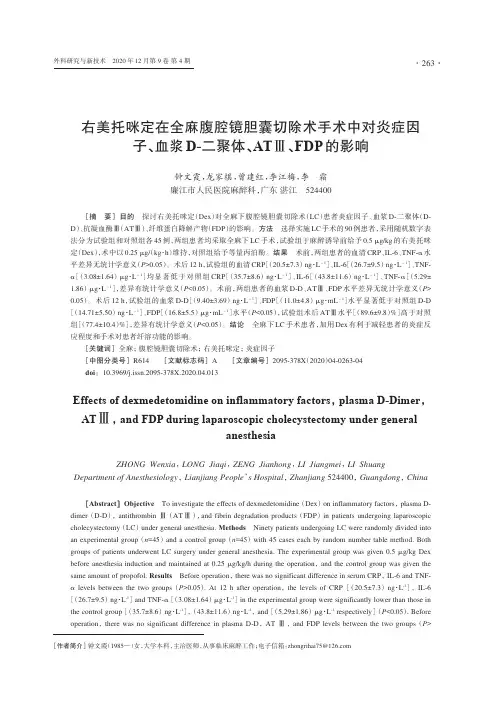
右美托咪定在全麻腹腔镜胆囊切除术手术中对炎症因子、血浆D-二聚体、ATⅢ、FDP的影响钟文霞,龙家棋,曾建红,李江梅,李霜廉江市人民医院麻醉科,广东湛江524400[摘要]目的探讨右美托咪定(Dex)对全麻下腹腔镜胆囊切除术(LC)患者炎症因子、血浆D-二聚体(D-D)、抗凝血酶Ⅲ(ATⅢ)、纤维蛋白降解产物(FDP)的影响。
方法选择实施LC手术的90例患者,采用随机数字表法分为试验组和对照组各45例,两组患者均采取全麻下LC手术,试验组于麻醉诱导前给予0.5μg/kg的右美托咪定(Dex),术中以0.25μg/(kg·h)维持,对照组给予等量丙泊酚。
结果术前,两组患者的血清CRP、IL-6、TNF-α水平差异无统计学意义(P>0.05)。
术后12h,试验组的血清CRP[(20.5±7.3)ng·L-1]、IL-6[(26.7±9.5)ng·L-1]、TNF-α[(3.08±1.64)μg·L-1]均显著低于对照组CRP[(35.7±8.6)ng·L-1]、IL-6[(43.8±11.6)ng·L-1]、TNF-α[(5.29±1.86)μg·L-1],差异有统计学意义(P<0.05)。
术前,两组患者的血浆D-D、ATⅢ、FDP水平差异无统计学意义(P>0.05)。
术后12h,试验组的血浆D-D[(9.40±3.69)ng·L-1]、FDP[(11.0±4.8)μg·mL-1]水平显著低于对照组D-D[(14.71±5.50)ng·L-1]、FDP[(16.8±5.5)μg·mL-1]水平(P<0.05),试验组术后ATⅢ水平[(89.6±9.8)%]高于对照组[(77.4±10.4)%],差异有统计学意义(P<0.05)。
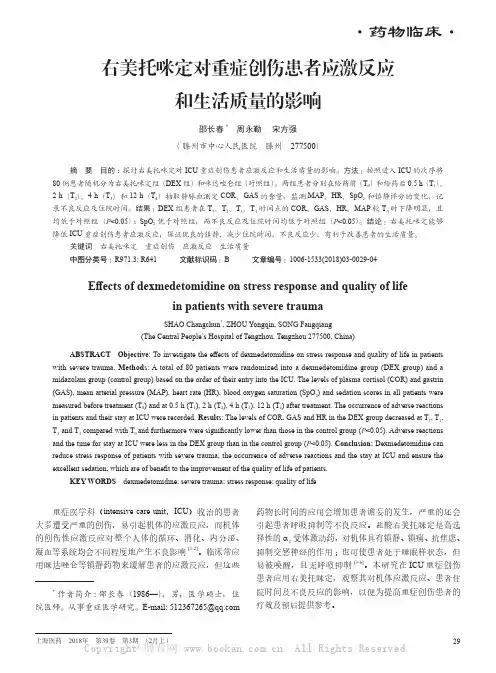
右美托咪定对重症创伤患者应激反应和生活质量的影响邵长春*周永勤 宋方强( 滕州市中心人民医院滕州 277500)摘要目的:探讨右美托咪定对ICU重症创伤患者应激反应和生活质量的影响。
方法:按照进入ICU的次序将80例患者随机分为右美托咪定组(DEX组)和咪达唑仑组(对照组)。
两组患者分别在给药前(T0)和给药后0.5 h(T1)、2 h(T2)、4 h(T3)和12 h(T4)抽取静脉血测定COR、GAS的含量,监测MAP、HR、SpO2和镇静评分的变化,记录不良反应及住院时间。
结果:DEX组患者在T1、T2、T3、T4时间点的COR、GAS、HR、MAP较T0时下降明显,且均低于对照组(P<0.05); SpO2优于对照组,而不良反应及住院时间均低于对照组(P<0.05)。
结论:右美托咪定能够降低ICU重症创伤患者应激反应,保证优良的镇静,减少住院时间,不良反应少,有利于改善患者的生活质量。
关键词右美托咪定重症创伤应激反应生活质量中图分类号:R971.3; R641 文献标识码:B 文章编号:1006-1533(2018)03-0029-04Effects of dexmedetomidine on stress response and quality of lifein patients with severe traumaSHAO Changchun*, ZHOU Yongqin, SONG Fangqiang(The Central People’s Hospital of Tengzhou, Tengzhou 277500, China)ABSTRACT Objective: To investigate the effects of dexmedetomidine on stress response and quality of life in patients with severe trauma. Methods: A total of 80 patients were randomized into a dexmedetomidine group (DEX group) and a midazolam group (control group) based on the order of their entry into the ICU. The levels of plasma cortisol (COR) and gastrin (GAS), mean arterial pressure (MAP), heart rate (HR), blood oxygen saturation (SpO2) and sedation scores in all patients were measured before treatment (T0) and at 0.5 h (T1), 2 h (T2), 4 h (T3), 12 h (T4) after treatment. The occurrence of adverse reactions in patients and their stay at ICU were recorded. Results: The levels of COR, GAS and HR in the DEX group decreased at T1, T2, T3 and T4 compared with T0and furthermore were significantly lower than those in the control group (P<0.05). Adverse reactions and the time for stay at ICU were less in the DEX group than in the control group (P<0.05). Conclusion: Dexmedetomidine can reduce stress response of patients with severe trauma, the occurrence of adverse reactions and the stay at ICU and ensure the excellent sedation, which are of benefit to the improvement of the quality of life of patients.KEY WORDS dexmedetomidine; severe trauma; stress response; quality of life重症医学科(intensive care unit,ICU)收治的患者大多遭受严重的创伤,易引起机体的应激反应,而机体的创伤性应激反应对整个人体的循环、消化、内分泌、凝血等系统均会不同程度地产生不良影响[1-2]。
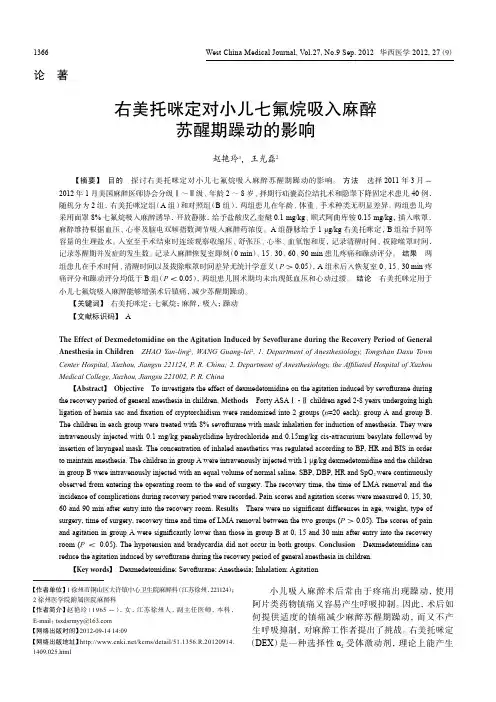
1366West China Medical Journal, Vol.27, No.9 Sep. 2012 华西医学 2012, 27(9)右美托咪定对小儿七氟烷吸入麻醉苏醒期躁动的影响赵艳玲1,王光磊2【摘要】 目的 探讨右美托咪定对小儿七氟烷吸入麻醉苏醒期躁动的影响。
方法 选择2011年3月-2012年1月美国麻醉医师协会分级Ⅰ~Ⅱ级、年龄2~8岁、择期行疝囊高位结扎术和隐睾下降固定术患儿40例,随机分为2组,右美托咪定组(A组)和对照组(B组),两组患儿在年龄、体重、手术种类无明显差异。
两组患儿均采用面罩8%七氟烷吸入麻醉诱导,开放静脉,给予盐酸戊乙奎醚0.1 mg/kg、顺式阿曲库铵0.15 mg/kg,插入喉罩,麻醉维持根据血压、心率及脑电双频指数调节吸入麻醉药浓度。
A组静脉给予1 μg/kg右美托咪定,B组给予同等容量的生理盐水。
入室至手术结束时连续观察收缩压、舒张压、心率、血氧饱和度,记录清醒时间、拔除喉罩时间,记录苏醒期并发症的发生数。
记录入麻醉恢复室即刻(0 min)、15、30、60、90 min患儿疼痛和躁动评分。
结果 两组患儿在手术时间、清醒时间以及拔除喉罩时间差异无统计学意义(P>0.05),A组术后入恢复室0、15、30 min疼痛评分和躁动评分均低于B组(P<0.05),两组患儿围术期均未出现低血压和心动过缓。
结论 右美托咪定用于小儿七氟烷吸入麻醉能够增强术后镇痛,减少苏醒期躁动。
【关键词】 右美托咪定;七氟烷;麻醉,吸入;躁动【文献标识码】 A The Effect of Dexmedetomidine on the Agitation Induced by Sevoflurane during the Recovery Period of GeneralAnesthesia in Children ZHAO Yan-ling1, WANG Guang-lei2. 1. Department of Anesthesiology, Tongshan Daxu TownCenter Hospital, Xuzhou, Jiangsu 221124, P. R. China; 2. Department of Anesthesiology, the Affiliated Hospital of XuzhouMedical College, Xuzhou, Jiangsu 221002, P. R. China【Abstract】 Objective To investigate the effect of dexmedetomidine on the agitation induced by sevoflurane during the recovery period of general anesthesia in children. Methods Forty ASAⅠ-Ⅱchildren aged 2-8 years undergoing highligation of hernia sac and fixation of cryptorchidism were randomized into 2 groups (n=20 each): group A and group B.The children in each group were treated with 8% sevoflurane with mask inhalation for induction of anesthesia. They wereintravenously injected with 0.1 mg/kg penehyclidine hydrochloride and 0.15mg/kg cis-atracurium besylate followed byinsertion of laryngeal mask. The concentration of inhaled anesthetics was regulated according to BP, HR and BIS in orderto maintain anesthesia. The children in group A were intravenously injected with 1 μg/kg dexmedetomidine and the childrenin group B were intravenously injected with an equal volume of normal saline. SBP, DBP, HR and SpO2 were continuouslyobserved from entering the operating room to the end of surgery. The recovery time, the time of LMA removal and theincidence of complications during recovery period were recorded. Pain scores and agitation scores were measured 0, 15, 30,60 and 90 min after entry into the recovery room. Results There were no significant differences in age, weight, type ofsurgery, time of surgery, recovery time and time of LMA removal between the two groups (P>0.05). The scores of painand agitation in group A were significantly lower than those in group B at 0, 15 and 30 min after entry into the recoveryroom (P<0.05). The hypotension and bradycardia did not occur in both groups. Conclusion Dexmedetomidine canreduce the agitation induced by sevoflurane during the recovery period of general anesthesia in children.【Key words】 Dexmedetomidine; Sevoflurane; Anesthesia; Inhalation; Agitation论 著【作者单位】 1徐州市铜山区大许镇中心卫生院麻醉科(江苏徐州,221124);2徐州医学院附属医院麻醉科【作者简介】赵艳玲(1965-),女,江苏徐州人,副主任医师,本科,E-mail:tsxdsrmyy@【网络出版时间】 2012-09-14 14:09【网络出版地址】 /kcms/detail/51.1356.R.20120914. 1409.025.html小儿吸入麻醉术后常由于疼痛出现躁动,使用阿片类药物镇痛又容易产生呼吸抑制。
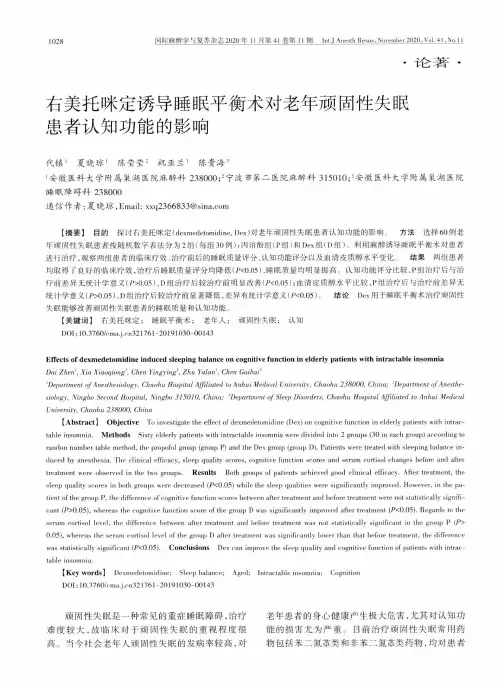
1028国际麻醉学与复苏杂志2020年丨丨月第41卷第11期 Int J Anesth Resus,November2020, Vol.41,No.11•论著•右美托咪定诱导睡眠平衡术对老年顽固性失眠患者认知功能的影响代镇,夏晓琼1陈莹莹2祝亚兰1陈贵海31安徽医科大学附属巢湖医院麻醉科238000;2宁波市第二医院麻醉科315010;3安徽医科大学附属巢湖医院睡眠障碍科238000通信作者:夏晓球,Email:xxq2366833@【摘要】目的探讨右美托咪定(dex m e d e t o m i d i n e.D e x)对老年顽固性失眠患者认知功能的影响。
方法选择60例老年顽固性失眠患者按随机数字表法分为2组(每组30例):丙泊酚组(P组)和D e x组(D组)。
利用麻醉诱导睡眠平衡术对患者进行治疗,观察两组患者的临床疗效、治疗前后的睡眠质量评分、认知功能评分以及血清皮质醇水平变化_结果两组患者均取得了良好的临床疗效,治疗后睡眠质量评分均降低(P<〇.〇5),睡眠质量均明显提高。
认知功能评分比较.P组治疗后与治疗前差异无统计学意义(P>〇.〇5),D组治疗后较治疗前明显改善(P<0.05);血清皮质醇水平比较,P组治疗后与治疗前差异无统计学意义(P>0.05),D组治疗后较治疗前显著降低,差异有统计学意义(P<0.05>。
结论D e x用于睡眠平衡术治疗顽固性失眠能够改善顽固性失眠患者的睡眠质量和认知功能【关键词】右美托咪定;睡眠平衡术;老年人;顽固性失眠;认知D01:10.3760/rm a.j.rn321761-20191030-00143Effects of dexmedetomidine induced sleeping balance on cognitive function in elderly patients with intractable insomniaDai Z hen1, Xia Xiaoqiong1, Chen Yingying2, Z h u Yalan1, Chen G uihai1'Department o f A nesthesiology, Chaohu Hospital Affiliated to A nhui Medical University, Chaohu 238000, China; d ep artm en t o f A nesthesiology, Ningbo Second Hospital, Ningbo 315010, China; departm en t o f Sleep Disorders, Chaohu Hospital Affiliated to Anhui Medical University, Chaohu 238000, China【Abstract】Objective To investigate the effect of dexmedetomidine (Dex) on cognitive function in elderly patients with intractable insomnia. Methods Sixty elderly patients with intractable insomnia were divided into 2 groups (30 in each group) according to randon number table method, the propofol group (group P) and the Dex group (group D). Patients were treated with sleeping balance induced by anesthesia. The clinical efficacy, sleep quality scores, cognitive function scores and serum cortisol changes before and after treatment were observed in the two groups. Results Both groups of patients achieved good clinical efficacy. After treatment, the sleep quality scores in both groups were decreased (P<0.05) while the sleep qualities were significantly improved. However, in the patient of the group P, the difference of cognitive function scores between after treatment and before treatment were not statistically significant (P>0.05), whereas the cognitive function score of the group D was significantly improved after treatment (P<0.05). Regards to the serum cortisol level, the difference between after treatment and before treatment was not statistically significant in the group P (P> 0.05), whereavS the serum cortisol level of the group D after treatment was significantly lower than that before treatment, the difference was statistically significant (P<0.05). Conclusions Dex can improve the sleep quality and cognitive function of patients with intractable insomnia.【Keywords】Dexmedetomidine; Sleep balance; Aged; Intractable insomnia; CognitionDOI:10.3760/rm a.j.rn321761-20191030-00143顽固性失眠是一种常见的重症睡眠障碍,治疗 难度较大,故临床对于顽同性失眠的重视程度很高。
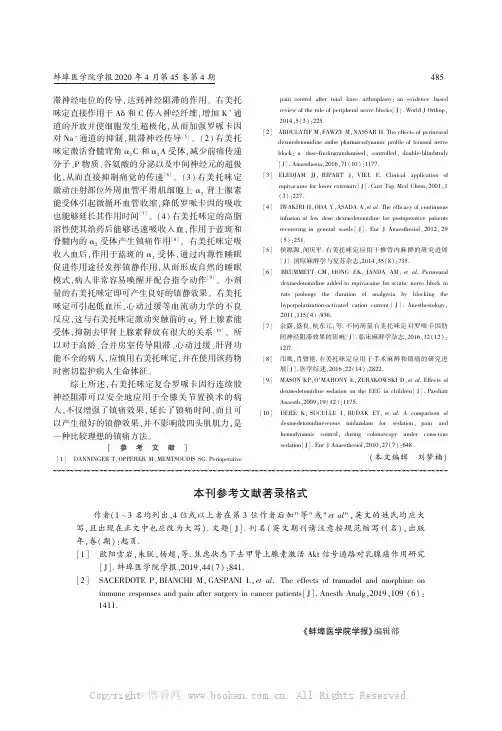
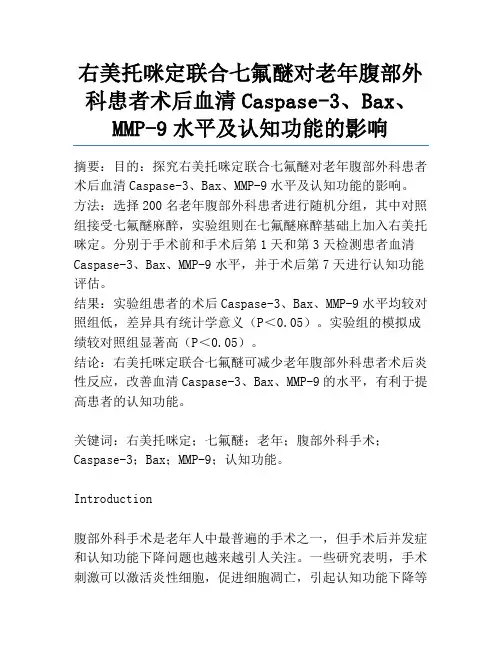
右美托咪定联合七氟醚对老年腹部外科患者术后血清Caspase-3、Bax、MMP-9水平及认知功能的影响摘要:目的:探究右美托咪定联合七氟醚对老年腹部外科患者术后血清Caspase-3、Bax、MMP-9水平及认知功能的影响。
方法:选择200名老年腹部外科患者进行随机分组,其中对照组接受七氟醚麻醉,实验组则在七氟醚麻醉基础上加入右美托咪定。
分别于手术前和手术后第1天和第3天检测患者血清Caspase-3、Bax、MMP-9水平,并于术后第7天进行认知功能评估。
结果:实验组患者的术后Caspase-3、Bax、MMP-9水平均较对照组低,差异具有统计学意义(P<0.05)。
实验组的模拟成绩较对照组显著高(P<0.05)。
结论:右美托咪定联合七氟醚可减少老年腹部外科患者术后炎性反应,改善血清Caspase-3、Bax、MMP-9的水平,有利于提高患者的认知功能。
关键词:右美托咪定;七氟醚;老年;腹部外科手术;Caspase-3;Bax;MMP-9;认知功能。
Introduction腹部外科手术是老年人中最普遍的手术之一,但手术后并发症和认知功能下降问题也越来越引人关注。
一些研究表明,手术刺激可以激活炎性细胞,促进细胞凋亡,引起认知功能下降等不良影响。
因此,寻找一种有效的方法来减少术后炎性反应,改善认知功能是非常必要的。
Methods选择200名老年腹部外科患者进行随机分组,其中对照组接受七氟醚麻醉,实验组则在七氟醚麻醉基础上加入右美托咪定。
分别于手术前和手术后第1天和第3天检测患者血清Caspase-3、Bax、MMP-9水平,并于术后第7天进行认知功能评估。
Results实验组患者的术后Caspase-3、Bax、MMP-9水平均较对照组低,差异具有统计学意义(P<0.05)。
实验组的模拟成绩较对照组显著高(P<0.05)。
Conclusions右美托咪定联合七氟醚可减少老年腹部外科患者术后炎性反应,改善血清Caspase-3、Bax、MMP-9的水平,有利于提高患者的认知功能。
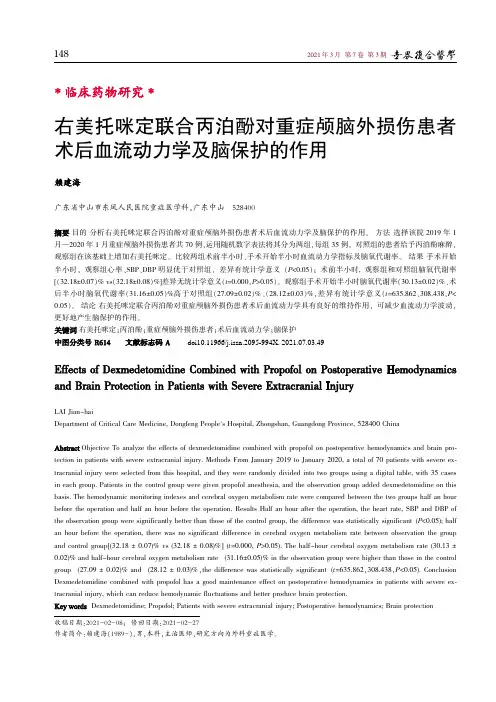
2021年3月第7卷第3期右美托咪定联合丙泊酚对重症颅脑外损伤患者术后血流动力学及脑保护的作用广东省中山市东凤人民医院重症医学科,广东中山528400目的分析右美托咪定联合丙泊酚对重症颅脑外损伤患者术后血流动力学及脑保护的作用。
方法选择该院2019年1月—2020年1月重症颅脑外损伤患者共70例,运用随机数字表法将其分为两组,每组35例。
对照组的患者给予丙泊酚麻醉,观察组在该基础上增加右美托咪定。
比较两组术前半小时、手术开始半小时血流动力学指标及脑氧代谢率。
结果手术开始半小时,观察组心率、SBP、DBP明显优于对照组,差异有统计学意义(P<0.05);术前半小时,观察组和对照组脑氧代谢率[(32.18±0.07)%vs(32.18±0.08)%]差异无统计学意义(t=0.000,P>0.05)。
观察组手术开始半小时脑氧代谢率(30.13±0.02)%、术后半小时脑氧代谢率(31.16±0.05)%高于对照组(27.09±0.02)%、(28.12±0.03)%,差异有统计学意义(t=635.862、308.438,P< 0.05)。
结论右美托咪定联合丙泊酚对重症颅脑外损伤患者术后血流动力学具有良好的维持作用,可减少血流动力学波动,更好地产生脑保护的作用。
右美托咪定;丙泊酚;重症颅脑外损伤患者;术后血流动力学;脑保护doi10.11966/j.issn.2095-994X.2021.07.03.49LAI Jian-haiDepartment of Critical Care Medicine,Dongfeng People's Hospital,Zhongshan,Guangdong Province,528400ChinaObjective To analyze the effects of dexmedetomidine combined with propofol on postoperative hemodynamics and brain pro⁃tection in patients with severe extracranial injury.Methods From January2019to January2020,a total of70patients with severe ex⁃tracranial injury were selected from this hospital,and they were randomly divided into two groups using a digital table,with35cases in each group.Patients in the control group were given propofol anesthesia,and the observation group added dexmedetomidine on this basis.The hemodynamic monitoring indexes and cerebral oxygen metabolism rate were compared between the two groups half an hour before the operation and half an hour before the operation.Results Half an hour after the operation,the heart rate,SBP and DBP of the observation group were significantly better than those of the control group,the difference was statistically significant(P<0.05);half an hour before the operation,there was no significant difference in cerebral oxygen metabolism rate between observation the group and control group[(32.18±0.07)%vs(32.18±0.08)%](t=0.000,P>0.05).The half-hour cerebral oxygen metabolism rate(30.13±0.02)%and half-hour cerebral oxygen metabolism rate(31.16±0.05)%in the observation group were higher than those in the control group(27.09±0.02)%and(28.12±0.03)%,the difference was statistically significant(t=635.862,308.438,P<0.05).Conclusion Dexmedetomidine combined with propofol has a good maintenance effect on postoperative hemodynamics in patients with severe ex⁃which can reduce hemodynamic fluctuations and better produce brain protection.Dexmedetomidine;Propofol;Patients with severe extracranial injury;Postoperative hemodynamics;Brain protection收稿日期:2021-02-08;修回日期:2021-02-27作者简介:赖建海(1989-),男,本科,主治医师,研究方向为外科重症医学。
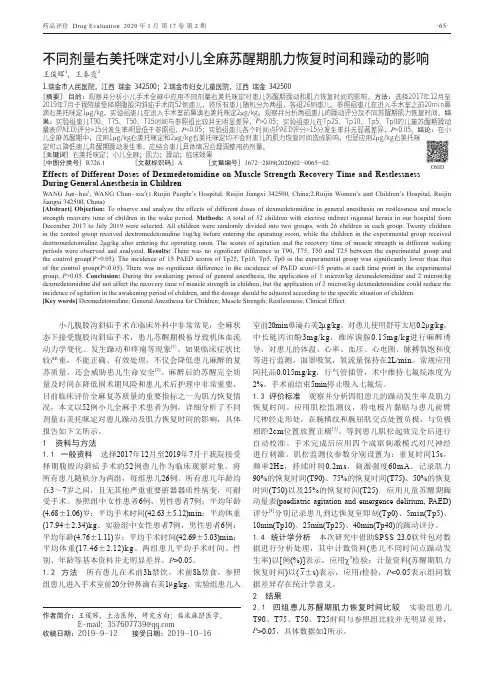
小儿腹股沟斜疝手术在临床外科中非常常见,全麻状态下接受腹股沟斜疝手术,患儿苏醒期极易导致机体血流动力学变化、发生躁动和疼痛等现象[1]。
如果临床症状比较严重,不能正确、有效处理,不仅会降低患儿麻醉的复苏质量,还会威胁患儿生命安全[2]。
麻醉后的苏醒完全质量及时间在降低围术期风险和患儿术后护理中非常重要,目前临床评价全麻复苏质量的重要指标之一为肌力恢复情况,本文以52例小儿全麻手术患者为例,详细分析了不同剂量右美托咪定对患儿躁动及肌力恢复时间的影响,具体报告如下文所示。
1 资料与方法1.1 一般资料 选择2017年12月至2019年7月于我院接受择期腹股沟斜疝手术的52例患儿作为临床观察对象。
将所有患儿随机分为两组,每组患儿26例。
所有患儿年龄均在3~7岁之间,且无其他严重重要脏器器质性病变,可耐受手术。
参照组中女性患者6例,男性患者7例;平均年龄(4.68±1.06)岁;平均手术时间(42.63±5.12)min;平均体重(17.94±2.34)kg。
实验组中女性患者7例,男性患者6例;平均年龄(4.76±1.11)岁;平均手术时间(42.69±5.03)min;平均体重(17.46±2.12)kg。
两组患儿平均手术时间、性别、年龄等基本资料并无明显差异,P>0.05。
1.2 方法 所有患儿在术前3h禁饮,术前8h禁食。
参照组患儿进入手术室前20分钟鼻滴右美1μg/kg,实验组患儿入室前20min鼻滴右美2μg/kg。
对患儿使用舒芬太尼0.2μg/kg,中长链丙泊酚3mg/kg,维库溴胺0.15mg/kg进行麻醉诱导,对患儿的体温、心率、血压、心电图、脉搏氧饱和度等进行监测。
面罩吸氧,氧流量保持在2L/min。
常规应用阿托品0.015mg/kg,行气管插管,术中维持七氟烷浓度为2%,手术前结束5min停止吸入七氟烷。
1.3 评价标准 观察并分析四组患儿的躁动发生率及肌力恢复时间。
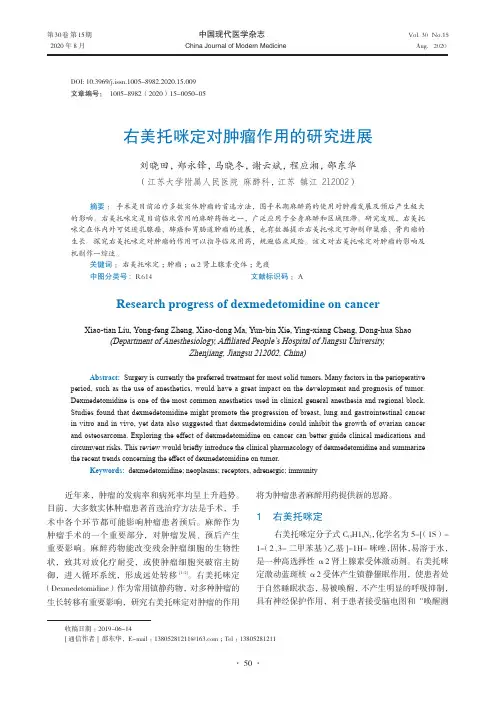
第30卷 第15期 中国现代医学杂志 Vol. 30 No.15 2020年 8月 China Journal of Modern Medicine Aug. 2020收稿日期:2019-06-14[通信作者] 邵东华,E-mail :138****************;Tel :138****1211DOI: 10.3969/j.issn.1005-8982.2020.15.009文章编号: 1005-8982(2020)15-0050-05右美托咪定对肿瘤作用的研究进展刘晓田,郑永锋,马晓冬,谢云斌,程应湘,邵东华(江苏大学附属人民医院 麻醉科,江苏 镇江 212002)摘要: 手术是目前治疗多数实体肿瘤的首选方法,围手术期麻醉药的使用对肿瘤发展及预后产生极大的影响。
右美托咪定是目前临床常用的麻醉药物之一,广泛应用于全身麻醉和区域阻滞。
研究发现,右美托咪定在体内外可促进乳腺癌、肺癌和胃肠道肿瘤的进展,也有数据提示右美托咪定可抑制卵巢癌、骨肉瘤的生长。
探究右美托咪定对肿瘤的作用可以指导临床用药,规避临床风险。
该文对右美托咪定对肿瘤的影响及机制作一综述。
关键词: 右美托咪定;肿瘤;α2肾上腺素受体;免疫中图分类号: R614文献标识码: AResearch progress of dexmedetomidine on cancerXiao-tian Liu, Yong-feng Zheng, Xiao-dong Ma, Yun-bin Xie, Ying-xiang Cheng, Dong-hua Shao(Department of Anesthesiology, Affiliated People’s Hospital of Jiangsu University,Zhenjiang, Jiangsu 212002, China)Abstract: Surgery is currently the preferred treatment for most solid tumors. Many factors in the perioperative period, such as the use of anesthetics, would have a great impact on the development and prognosis of tumor. Dexmedetomidine is one of the most common anesthetics used in clinical general anesthesia and regional block. Studies found that dexmedetomidine might promote the progression of breast, lung and gastrointestinal cancer in vitro and in vivo, yet data also suggested that dexmedetomidine could inhibit the growth of ovarian cancer and osteosarcoma. Exploring the effect of dexmedetomidine on cancer can better guide clinical medications and circumvent risks. This review would briefly introduce the clinical pharmacology of dexmedetomidine and summarize the recent trends concerning the effect of dexmedetomidine on tumor.Keywords: dexmedetomidine; neoplasms; receptors, adrenergic; immunity近年来,肿瘤的发病率和病死率均呈上升趋势。
262 世界睡眠医学杂志WorldJournalofSleepMedicine2021年2月第8卷第2期February.2021,Vol.8,No.2右美托咪定对老年患者椎管内麻醉术后睡眠质量的影响胡俊毅(襄阳市谷城县人民医院,襄阳,441700)摘要 目的:探讨右美托咪定对老年患者椎管内麻醉术后睡眠质量的影响。
方法:选取2019年6月至2020年5月襄阳市谷城县人民医院收治的需进行麻醉的老年手术患者88例作为研究对象,随机分为观察组和对照组,每组44例。
对照组应用常规腰硬联合麻醉,观察组在对照组基础上应用右美托咪定进行辅助镇静干预。
比较分析2组切皮前后各时间点Ramsay评分和睡眠障碍发生率。
结果:与切皮前比较,观察组各时间点Ramsay评分均降低,观察组各时间点Ramsay评分均升高,差异均有统计学意义(P<0 05);2组切皮后个时间点Ramsay评分比较,差异均有统计学意义(P<0 05);观察组睡眠障碍发生率为4 5%,低于对照组的31 9%,差异有统计学意义(P<0 05)。
结论:老年患者行椎管内麻醉时应用右美托咪定辅助镇静,麻醉效果更佳,显著提高了患者的睡眠质量,值得临床推广应用。
关键词 右美托咪定;辅助镇静;椎管;麻醉;睡眠质量EffectsofDexmedetomidineonSleepQualityafterIntravertebralAnesthesiainElderlyPatientsHUJunyi(GuchengCountyPeople′sHospital,GuchengCounty,Xiangyang441700,China)Abstract Objective:Toinvestigatetheeffectofdextrometramidineonsleepqualityafterspinalanesthesiainelderlypatients Methods:Atotalof88elderlypatientswhoneedanesthesiafromjune2019tomay2020wereselectedasthestudysub jects,randomlydividedintoobservationgroupandcontrolgroup,eachgroupof44cases Thecontrolgroupwasgivenroutinelumbarandhardcombinedanesthesia,andtheobservationgroupwasusedrightmetomidinetoassistsedationinterventiononthebasisofthecontrolgroup Ramsayscoreandsleepdisorderratewereobservedandcomparedbeforeandafterskincutting Results:com paredwiththepreskincutting,Ramsayscoreofobservationgroupwasdecreasedatalltimepoints,andRamsayscoreofobserva tiongroupwasincreased,andthedifferencewasstatisticallysignificant(P<0 05);thedifferencewasstatisticallysignificant(P<0 05) Conclusion:thesedationofelderlypatientswithrightmetomidineisbetterwhentheyareunderspinalanesthesia,whichcanimprovethesleepqualityofthepatients,anditisworthpopularizingandapplying.Keywords Dextrometramidine;Assistedsedation;Spinalcanal;Anesthesia;Sleepquality中图分类号:R614 3;R338 63文献标识码:Adoi:10.3969/j.issn.2095-7130.2021.02.036 椎管内麻醉属于区域性的阻滞,仅对大脑产生微弱影响,但还是会导致患者出现焦虑、烦躁、躁动等不良情绪,不利于睡眠进而使术后康复受到极大影响[1]。
doi:10.3969/j.issn.1009⁃6469.2020.11.042◇药物与临床◇氟比洛芬酯复合右美托咪定对腹腔镜胆囊切除术老年病人七氟醚阻滞肾上腺素能反应最低肺泡有效浓度的影响张鹏,陈俊,张繁,王绍林作者单位:芜湖市第二人民医院麻醉科,安徽芜湖241000通信作者:王绍林,男,主任医师,研究方向为老年病人的麻醉,E⁃mail:***************摘要:目的观察氟比洛芬酯复合右美托咪定对腹腔镜胆囊切除手术老年病人七氟醚阻滞肾上腺素能反应的最低肺泡有效浓度(MAC BAR)的影响。
方法选择2018年2月至2019年2月芜湖市第二人民医院行腹腔镜胆囊切除手术老年病人44例,采用随机数字表法分为观察组23例和对照组21例。
观察组在诱导前15min静脉注射右美托咪定0.5μg/kg(10min注射完),然后以0.2μg·kg-1·h-1维持,且插管完成后给予氟比洛芬酯50mg静脉注射。
对照组给予等量生理盐水,术毕前给予氟比洛芬酯50mg静脉注射。
麻醉诱导气管插管后机械通气,吸入七氟醚维持麻醉。
观察气腹刺激后血流动力学变化,采用序贯法测定七氟醚MAC BAR。
结果观察组平均动脉压(MAP)气腹后(79±7)mmHg较气腹前(75±9)mmHg比较,差异无统计学意义(P>0.05)。
对照组MAP气腹后(82±7)mmHg较气腹前(73±7)mmHg明显升高,差异有统计学意义(P<0.05)。
观察组七氟醚MAC BAR为1.85%(95%CI:1.45%~2.25%),对照组七氟醚MAC BAR为2.35%(95%CI:2.19%~2.51%),两组比较差异有统计学意义(P<0.05)。
观察组七氟醚MAC BAR较对照组降低21.3%。
结论氟比洛芬酯复合右美托咪定可降低腹腔镜手术老年病人七氟醚MAC BAR。
关键词:麻醉,吸入;胆囊切除术,腹腔镜;氟比洛芬;右美托咪定;七氟醚;最低肺泡有效浓度;老年人Effects of dexmedetomidine cominded with flurbiprofenaxetil on MAC BAR of sevoflurane in elder patientsunder⁃going laparoscopic surgeryZHANG Peng,CHEN Jun,ZHANG Fan,WANG ShaolinAuthor Affiliation:Department of Anesthesiology,Wuhu No.2People’s Hospital,Wuhu,Anhui241000,ChinaAbstract:Objective To observe the effect of dexmedetomidine combined with flurbiprofen axetil on the minimum alveolar concen⁃tra⁃tion of sevoflurane(MAC BRA)for blocking adrenergic response in elder patients during laparoscopic cholecystectomy surgery. Methods44elder patients with ASAⅠ⁃Ⅱundergoing laparoscopic cholecystectomy surgery in Wuhu No.2People’s Hospital from February2018to February2019were randomly divided into two groups,experiment group(group E,n=23)and control group (group C,n=21).Dexmedetomidine combined with flurbiprofen axetil were infused before pneumoperitoneum stimulation in group E.The hemodynamic changes(MAP,HR)were observed after pneumoperitoneum stimulation.The MAC BRA of sevoflurane in each group was measured by sequential method.Results The MAC BAR Of sevoflurane was1.85%(95%C1:1.45%⁃2.25%)in the group E and2.35%(95%CI:2.19%⁃2.51%)in the group C(P<0.05),and21.3%less the group E was than the group C.Conclusion Dexmedetomidine combined with flurbiprofen axetil can reduce the MAC BRA of sevoflurane in elder patients undergoing laparoscopic surgery by21.3%,and make hemodynamics become more smooth.Key words:Anesthesia,inhalation;Cholecystectomy,laparoscopic;Flurbiprofen axetil;Dexmedetomidine;Sevoflurane;Minimum alveolar concentration;Aged随着快速康复外科的理念逐步进入麻醉学科[1],基于此理念之下,右美托咪定由于其镇痛、镇静、抗焦虑的药理作用,又同时能有效抑制病人术中和术后的应激反应及免疫抑制反应[2],故而开始逐步取代传统术前用药,广泛应用于各类手术的术前准备。
论著与临床右美托咪定复合地塞米松对剖宫产术后镇痛效果及产后抑郁的影响石少凯,骆东超■*基金项目:秦皇岛市科技计划自筹经费项目(项目编号:2〇1902A208)作者单位:〇66200河北秦皇岛,秦皇岛市工人医院麻醉科作者简介:石少凯,毕业于河北北方学院,本科,主治医师,主要研究方向为产科麻醉’通讯作者,E-m ail:l4769〇2l*********【摘要】目的探讨剖宫产术后采用右美托咪定复合地塞米松是否有利于减少镇痛药物的用量和产后抑郁的发生。
方法选择2018年11月至2019年11月秦皇岛市工人医院行择期剖宫产术的120例患者,根据随机数字表分为右美托咪定复合地塞米松组(A组)和对照组(B组)。
术后所有患者均采用静脉镇痛泵进行镇痛,其中A组采用术后单次静脉注射3.5 u g/k g的地塞米松复合舒芬太尼1.5 ug/kg +右美托咪定1.5 ug/kg +生理盐水至150 m L的静脉镇痛,B组采用舒芬太尼1.5 u g/kg +生理盐水至150 m L的静脉镇痛。
观察两组术后4 h、8 h、12 h、24 h和48 h的视觉模拟评分法(Visual Analogue S c a l e,V A S)疼痛评分及镇痛药物使用情况,记录产后5~6周内采用爱丁堡产后抑郁量表(Edinburgh Postnatal Depression Scale,E P D S)进行的抑郁评分。
结果A组术后4 h、8 h、12 h和24 h的静息和运动的V A S疼痛评分较B组明显降低,差异有统计学意义(P<0.05) ,A组术后48 h内镇痛药物使用量比B组明显减少,差异有统计学意义(Z5 <0.05),A组患者在术后E P D S评分和发生产后抑郁人数比B组均明显降低,差异有统计学意义(尸<0.05)。
结论右美托咪定复合地塞米松用于剖宫产术后镇痛不仅有利于减少患者对术后镇痛药物的需求,而且有利于降低患者产后抑郁发生率。
复旦学报(医学版)2020Nov.,47(6)825 Fudan Univ J Med Sci右美托咪定对新辅助化疗后乳腺癌患者术后痛觉过敏的影响董静1,3▲邢茜2,3▲张浩1,3陈万坤1,3缪长虹1,3△(1复旦大学附属肿瘤医院麻醉科,2麻醉科重症监护室上海200032;3复旦大学上海医学院肿瘤学系上海200032)【摘要】目的探讨右美托咪定对化疗后乳腺癌患者术后痛觉过敏的影响。
方法选择择期行乳腺癌改良根治手术的患者120例,将患者分为3组:对照组(C组,n=40)、新辅助化疗组(N组,n=40)和新辅助化疗术前应用右美托咪定组(D组,n=40)。
采用视觉模拟评分(Visual Analogue Scale,VAS)和机械痛阈测定分别于患者术后24h (T5)、48h(T6)和72h(T7)进行痛觉评估。
结果与C组相比,N组患者在T5~T7时间点机械痛阈明显下降(P<0.001,P=0.037,0.023),VAS评分显著增加(P=0.012,0.002,0.036);与N组相比,D组患者在术后T5~T7时间点的机械痛阈升高(P=0.021,0.004,0.013),VAS评分显著降低(P=0.031,0.024,0.032)。
D组患者在围术期的心率(heart rate,HR)和平均动脉压(mean arterial pressure,MAP)更加平稳;术后再次镇痛患者比例下降,发生躁动不良反应减少。
结论右美托咪定可安全有效地缓解新辅助化疗后乳腺癌患者术后痛觉敏感性。
【关键词】右美托咪定;新辅助化疗;乳腺癌;疼痛;痛觉过敏【中图分类号】R614【文献标志码】A doi:10.3969/j.issn.1672-8467.2020.06.004Effects of dexmedetomidine on postoperative hyperalgesia in breast cancer patients after neoadjuvant chemotherapy DONG Jing1,3▲,XING Qian2,3▲,ZHANG Hao1,3,CHEN Wan-kun1,3,MIAO Chang-hong1,3△(1Department of Anesthesiology,2Department of Anesthesiology Intensive Care Unit,Shanghai Cancer Center,Fudan University,Shanghai200032,China;3Department of Oncology,Shanghai Medical College,Fudan University,Shanghai200032,China)国家自然科学基金青年项目(81701045)▲DONG Jing and XING Qian contributed equally to this work△Corresponding author E-mail:******************网络首发时间:2020-07-2011∶23∶33网络首发地址:https:///kcms/detail/31.1885.R.20200717.0831.016.html复旦学报(医学版)2020年11月,47(6)postoperative pain sensitivity of breast cancer patients after neoadjuvant chemotherapy.【Key words】dexmedetomidine;neoadjuvant chemotherapy;breast cancer;pain;hyperalgesia*This work was supported by the Youth Program of National Natural Science Foundation of China(81701045).乳腺癌是全球女性发病率和死亡率最高的恶性肿瘤之一。
DOI : 10.3969/j.issn.l672-9463.2018.01.005右美托咪啶对气管插管期心血管应激反应的影响史创国薛荣亮【摘要】目的观察右美托咪陡(Dexmedetomidine,DXM)预防全麻气管插管期心血管应激反应的效果。
方法选择拟在全身麻醉下择期行腹腔镜胆囊切除手术患者50例,ASA I〜II级,随机分为对照组和观察组(n=25)D对照组麻醉 诱导前静脉输注等剂量生理盐水,观察组麻醉诱导前静脉输注右美托咪啶(初始剂量1.0 Hg/kg,输注lOmin)。
麻醉诱导 后行气管插管机械通气。
记录入室后(% )、气管插管前)和气管插管后即刻(T2)血压(MAP)、心率(HR)和TQ与T2时 刻的血糖浓度。
结果与T。
比较,气管插管前两组MAP均降低,差异有统计学意义(P<0.05或P<0.01);与对照组比较,观察组MAP下降幅度明显减小,差异有统计学意义(P<0.01 );对照组与观察组比较H R明显降低,差异有统计学意义 (尸<0.01 )。
与T。
比较,气管插管后对照组MAP、HR和血糖浓度均明显升高,差异有统计学意义(P<D.01或尸<0.05 );观 察组MAP、HR和血糖浓度无明显升高,差异无统计学意义(P>0.05 );与对照组比较,观察组MAP、HR和血糖浓度变化幅度差异有统计学意义(P<〇.〇5)。
结论右美托咪啶可减轻全身麻醉诱导后血压的过度降低,降低气管插管时的心血 管应激反应,维持稳定的血流动力学。
【关键词】右美托咪啶气管插管心血管应激反应Effects of dexmedetomidine on cardiovascular stress response in tracheal intubation under general anesthesia Shi Chuangguo, Xue Rongliang. Department o f A nesthesiology, the Second A ffiliated Hospital o f X i’a n Jiaotong University, Xi’a n 710004[Abstract] Objective To observe the effects of dexmedetomidine (DXM) on cardiovascular stress response in tracheal intubation. Methods Fifty ASA I〜II patients scheduled for laparoscopic cholecystectomy were randommized into control group treated with normal saline and observation group with DXM. In observation group, before induction of anesthesia, 1.0|xg/kg of DXM were continuously pumped lOmin.Patients of control group were continuously infused saline as controls. After anesthesia induction, the patients were mechanically ventilated. Mean artery pressure (MAP) and heart rate (HR) were recorded before infusion of dexmedetomidine(T0), before intubationCTj), immediately after intubation(T2) and the blood glucose concentration (GLU) at T〇and T2 moments. Results Before intubation of anesthesia, comparing with T〇, MAP at Tj decreased significantly in two groups (P<0.01 or P<0.05).Intergroup comparison showed that observation group was notably higher than control group in MAP at T! (P<0.01) and control group was notably higher than observation group in HR at Tj (P<0.01). After intubation of anesthesia, comparing with T0, MAP, HR and GLU significantly increased at T2in control group(P<0.01 or _P<0.05). MAP, HR and GLU didn’t increase at T2 in observation group (P>0.05). Intergroup comparison showed that control group were notably higher than observation group in MAP, HR and GLU at T2 (P<0.01 or P<0.05). Conclusion DXM is beneficial to stabilizing the haemodynamics and reducing the cardiovascular response to endotracheal intubation under general anesthesia.【Key words】Dexmedetomidine Tracheal intubation Cardiovascular Stress response作者单位:710004陕西西安,西安交通大学第二附属医院麻醉科[史创国(在职研究生,现工作单位为西安航天总医院)、薛荣亮]通讯作者:薛荣壳,E-mail: x uerl299@近年来,随着加速术后康复(Enhanced Recovery After Surgery,ERAS)理论在临床的推广和应用,如何在围手术期降低伤害性应激反应对机体造成的 影响,维持重要器官功能,已经成为临床麻醉关注 的重点。
The Effects of Dexmedetomidine on Cardiac Electrophysiology in ChildrenGregory B.Hammer,MD*†David R.Drover,MD*Hong Cao,MD*Ethan Jackson,MD* Glyn D.Williams,MB,ChB* Chandra Ramamoorthy,MBBCHir* George F.Van Hare,MD†Alisa Niksch,MD†Anne M.Dubin,MD†BACKGROUND:Dexmedetomidine(DEX)is an␣2-adrenergic agonist that is approved by the Food and Drug Administration for short-term(Ͻ24h)sedation in adults.It is not approved for use in children.Nevertheless,the use of DEX for sedation and anesthesia in infants and children appears to be increasing.There are some concerns regarding the hemodynamic effects of the drug,including bradycardia, hypertension,and hypotension.No data regarding the effects of DEX on the cardiac conduction system are available.We therefore aimed to characterize the effects of DEX on cardiac conduction in pediatric patients.METHODS:Twelve children between the ages of5and17yr undergoing electrophysi-ology study and ablation of supraventricular accessory pathways had hemody-namic and cardiac electrophysiologic variables measured before and during administration of DEX(1g/kg IV over10min followed by a10-min continuous infusion of0.7g⅐kgϪ1⅐hϪ1).RESULTS:Heart rate decreased while arterial blood pressure increased significantly after DEX administration.Sinus node function was significantly affected,as evidenced by an increase in sinus cycle length and sinus node recovery time. Atrioventricular nodal function was also depressed,as evidenced by Wenckeback cycle length prolongation and prolongation of PR interval.CONCLUSION:DEX significantly depressed sinus and atrioventricular nodal function in pediatric patients.Heart rate decreased and arterial blood pressure increased during administration of DEX.The use of DEX may not be desirable during electrophysiology study and may be associated with adverse effects in patients at risk for bradycardia or atrioventricular nodal block.(Anesth Analg2008;106:79–83)D exmedetomidine(DEX)is a highly selective␣2-adrenergic agonist that is approved by the Food and Drug Administration for short-term(Ͻ24h)sedation in adult patients in the intensive care unit.It is not approved for use in children1;however,the use of DEX in infants and children for sedation and analgesia in the pediatric intensive care unit has been re-ported.2–4In addition,there are a growing number of published reports describing the administration of DEX during anesthesia in adults and children.5,6 There is concern regarding the circulatory effects of DEX,including hypertension,hypotension,and bra-dycardia.7It is thought that hypertension is due to activation of peripheral␣2B-adrenergic receptors,lead-ing to vasoconstriction.8Hypertension may be a tran-sient,initial circulatory effect after an initial loading dose of DEX and may also be associated with continu-ous infusions resulting in high plasma concentra-tions.9Entry into the central nervous system(CNS) leads to activation of␣2A-adrenergic receptors in the locus coeruleus,causing a decrease in norepinephrine release.10,11This CNS effect of DEX is associated with a decrease in arterial blood pressure(MAP).The decrease in heart rate(HR)associated with the adminis-tration of DEX may be caused both by a reflex response at the sinus node to peripheral vasoconstriction and the decrease in sympathetic outflow from the CNS.At the cellular level,the interaction of DEX with ␣2-adrenergic receptors results in activation of G pro-teins.12This leads to a decrease in adenylate cyclase activity.13The resulting decrease in the intracellular concentration of cyclic adenosine monophosphate causes an alteration in ion channel conductance and decreased neuronal activation.14,15This accounts for the clinical effects of DEX.It is unknown whether the cardiac effects of DEX are related strictly to interaction with␣2A-adrenergic receptors in the CNS and␣2B-adrenergic receptors in the peripheral vasculature,or whether direct interaction with␣2-adrenergic recep-tors in the heart itself may play a role.The aim of this study was to characterize the effects of DEX on cardiac conduction in children.From the Departments of*Anesthesiology,and†Pediatrics, Lucile Packard Children’s Hospital and Stanford University School of Medicine,Stanford,California.Accepted for publication September11,2007.Reprints will not be available from the author.Address correspondence to Gregory B.Hammer,MD,Department of Anesthesia,Stanford University Medical Center,300Pasteur Dr., Stanford,CA94305-5640.Address e-mail to ham@.Copyright©2007International Anesthesia Research Society DOI:10.1213/01.ane.0000297421.92857.4eMETHODSAfter IRB approval and informed consent,12pa-tients were included in this study.They were5–17yrof age and scheduled for a cardiac electrophysiology(EP)study and ablation under anesthesia for a diag-nosis of supraventricular tachycardia(SVT).Patientsin whom ablation was attempted but not successful,aswell as those with atrioventricular(AV)nodal dys-function,were excluded.Antiarrhythmic medicationswere discontinued in all patients at least3days beforethe procedure.Patient monitoring included electrocardiogram(ECG),noninvasive MAP,skin temperature,pulseoximetry,and capnography.Supplemental oxygenwas administered via nasal cannula or facemask dur-ing spontaneous breathing.Patients were premedi-cated with midazolam(0.5mg/kg up to20mg PO or1–2mg IV)as needed.Continuous infusions of propo-fol75–125g⅐kgϪ1⅐minϪ1IV and ketamine3.75–12.5g⅐kgϪ1⅐minϪ1were administered to achieve an adequate level of sedation and analgesia for catheterinsertion and EP study and ablation.Once stable anesthesia was achieved,the rightfemoral vein and right internal jugular vein were cath-eterized using standard techniques.Electrode catheterswere advanced to the right atrial appendage,rightventricular apex,His Bundle location,and coronarysinus.A diagnostic EP study was then performed usinga standard protocol.If SVT was not induced in thebaseline state,isoproterenol(0.01–0.04g⅐kgϪ1⅐minϪ1) was added and the protocol repeated.Once the ar-rhythmia focus was identified,radiofrequency or cryoablation was performed.After a30-min observation period to ensure thesuccess of the ablation and to allow offset of theisoproterenol,baseline EP data were recorded.Base-line surface ECG intervals,including PR,QRS,QTinterval corrected for rate using Bazett’s formula(QTc),and sinus cycle length,were measured.Intra-cardiac intervals,specifically atrial-His and His-ventricular intervals,were measured.Sinus nodefunction was assessed by measuring corrected sinusnode recovery times using standard techniques,mea-suring the return interval after30s of progressiveright atrial overdrive pacing cycle lengths until thereturn interval did not further prolong.The maximumrecovery interval was corrected by subtracting thesinus cycle length.AV nodal and atrial effectiverefractory periods were also measured by introducingprogressively more premature atrial stimuli aftereight-beat atrially-paced drive trains at a set cyclelength.Ventriculoatrial block cycle length was mea-sured with ventricular overdrive pacing.VA andventricular effective refractory periods were assessedwith placement of a ventricular extrastimulus after aneight-beat paced drive train in the ventricle.After recording of baseline EP data,DEX1g/kg IV was administered over10min,followed by a continuous infusion at a dose of0.7g⅐kgϪ1⅐hϪ1for 10min.The ECG and intracardiac electrograms were continuously recorded before and during this20-min infusion period.The identical EP data were again recorded after the20-min DEX infusion period in the same order as previously recorded before discontinu-ation of the drug.The EP study was terminated upon completion of this monitoring and data collection period.Indwelling catheters were removed,anesthet-ics were discontinued,and the patient was trans-ported to the postanesthesia care unit.Continuous observation of the ECG was performed in the postan-esthesia care unit until complete recovery from anes-thesia(i.e.,1–2h).Using study-specific flow sheets, nursing staff recorded vital signs every5min to document variations in HR and MAP.Any episodes of bradycardia and/or tachycardia(HRϽorϾ95% confidence limits for age,respectively)were recorded. As per routine for EP studies at this institution, patients were discharged4–6h after completion of their procedure.SPSS version15.0for Windows was used for statis-tical parisons of hemodynamic and re-spiratory variables were made from baseline versus10 and20min after initiation of DEX infusion using one-way ANOVA with post hoc comparisons of indi-vidual means by Tukey’s HSD test.Two-sided paired Student’s t-test compared the EP variable measured in a baseline state and after the20-min infusion of DEX. All results are expressed as meanϮsd.A P value of Ͻ0.05was considered statistically significant.RESULTSPatientsFifteen patients were enrolled.One patient was withdrawn due to unsuccessful ablation,and two patients were withdrawn due to unanticipated AV nodal dysfunction.Twelve patients(7females and5 males)with a median age of13yr(5–17yr)and a median weight of59.5kg(20–117kg)were studied. All patients studied underwent successful ablation. Seven of the12patients received isoproterenol during the EP study.Hemodynamic and Respiratory VariablesA significant increase in MAP was seen compared with baseline(66.2Ϯ9.3mm Hg)at10min(78.5Ϯ8.9 mm Hg,Pϭ0.006)but not at20min(71.3Ϯ9.1mm Hg)during administration of DEX(Table1).This was accompanied by a significant decrease in HR compared with baseline(94.3Ϯ19.8bpm)at10min(75.9Ϯ17.1 bpm,Pϭ0.045)but not at20min(80.1Ϯ16.8bpm).Respiratory rate and end-tidal carbon dioxide (ET co2)did not change with administration of DEX.EP VariablesSinus node function was significantly depressed after administration of DEX(Table2).Corrected sinusnode recovery times increased significantly from base-line.AV nodal function also showed depression after administration of DEX.AV nodal block cycle lengths and PR intervals significantly lengthened.Neither atrial nor ventricular muscle refractoriness changed significantly,although the change in ventricular effec-tive refractory period did approach statistical signifi-cance.QTc,a measure of ventricular repolarization that is influenced by autonomic input,also signifi-cantly increased,but no patient had an abnormally prolonged QTc(i.e.,QTcϾ445ms). DISCUSSIONWe found that DEX significantly depressed sinus and AV nodal function in pediatric patients.Sinus node recovery times(a measure of sinus automaticity) and baseline sinus cycle lengths,which are markers of sinus nodal function,were both lengthened with ad-ministration of DEX.AV nodal function,as evidenced by Wenckebach cycle length and AV nodal effective refractory periods,were also lengthened significantly.His-Purkinje conduction and atrial and ventricularmuscle properties were not affected.These effectsmight be related to a decrease in sympathetic outflowfrom the CNS and/or reflex effects secondary to anincrease in systemic vascular resistance.The concomi-tant decrease in HR and increase in MAP after theinitial10-min infusion of DEX,followed by the subse-quent decrease in MAP and increase in HR during thenext10min might suggest a reflex phenomenon.DEXdid not have a direct effect on ventricular or atrialrefractoriness,at least at the standard pacing sites cho-sen.No spontaneous AV nodal block was seen in thesepatients with normal baseline AV nodal conduction.No patient developed clinically significant brady-cardia during this study.Our patients were otherwisehealthy children with SVT.The changes we observedin sinus node and AV conduction might predisposepatients with selected comorbidities to significant bra-dycardia.Such patients might include those havingundergone cardiac surgery with conduction abnor-malities noted intraoperatively and/or suture lines inproximity to cardiac conduction tissue(e.g.,repair ofventricular septal defect,AV canal).Patients receivingother medications that affect cardiac conduction(e.g.,digoxin,-blockers,antiarrhythmic drugs)might also be at enhanced risk of bradycardia related to DEXinfusion,although further studies are needed to con-firm this.The incidence of bradycardia associated with DEXin adult patients is9%.16Although the bradycardiaobserved in clinical practice is usually mild,sinusarrest may occur.Peden et al.reported an episode ofsinus arrest in a patient who was lying quietly andtalking while receiving an initial loading dose of DEX(0.675g/kg over15min).17This required treatment with two doses of atropine0.6mg IV and a briefperiod of cardiac massage.Mitigating factors,such asthe effect of other drugs or the vagal stimulus ofintubation,could not be implicated.Two additionalpatients in this study had brief,self-limited periods ofsinus arrest during an initial loading dose of DEX(1g/kg over15min).These events occurred during laryngoscopy and the coadministration of propofoland alfentanil infusions.The authors of this studyrecommended that all patients under40yr of agereceiving dexmedetomidine should be pretreated withan anticholinergic drug.Significant bradycardias,in-cluding sinus pauses of3s,related to DEX have beenreported in up to40%of adult patients in otherTable1.Hemodynamic Variables at Baseline and at the Completion of an Initial Loading Dose(10min)and Subsequent Infusion (20min)of DexmedetomidineHeart rate(bpm)Respiratory rate(bpm)Mean arterial bloodpressure(mm Hg)ET co2(mm Hg)Baseline94.3Ϯ19.818.2Ϯ2.366.2Ϯ9.341.2Ϯ6.1 10min75.9Ϯ17.1*18.8Ϯ2.678.5Ϯ8.9†43.2Ϯ7.9 20min80.1Ϯ16.818.0Ϯ2.971.3Ϯ9.144.2Ϯ7.5 *Pϭ0.006;†Pϭ0.045.Table2.Electrophysiologic Variables at Baseline and After a20-min Infusion of DexmedetomidineBaseline DEX PSurface ECGintervalsSCL606Ϯ140ms788Ϯ165msϽ0.01PR144Ϯ19ms162Ϯ17msϽ0.01QRS76Ϯ11ms79Ϯ13ms NSQTc394Ϯ9ms424Ϯ9msϽ0.01Sinus automaticityCSNRT212Ϯ179ms293Ϯ180msϽ0.01Atrial musclepropertiesAERP207Ϯ31ms208Ϯ17ms NSAV nodalpropertiesAH interval73Ϯ14ms82Ϯ12msϽ0.01AVNBCL352Ϯ87ms436Ϯ105msϽ0.01AVNERP310Ϯ85ms360Ϯ88msϽ0.02VABCL372Ϯ111ms460Ϯ134msϽ0.01His PurkinjepropertiesHV interval40Ϯ7ms40Ϯ6ms NSVentricular musclepropertiesVERP220Ϯ22ms230Ϯ19ms0.06ECGϭelectrocardiogram;SCLϭsinus cycle length;PRϭPR interval;QRSϭQRS duration;QTCϭcorrected QT interval;CSNRTϭcorrected sinus node recovery time;AERPϭatrialeffective refractory period;AH intervalϭatrial–His interval;AVNBCLϭAV node block cyclelength;AVNERPϭAV node effective refractory period;VABCLϭventriculo-atrial block cyclelength;HV intervalϭHis-ventricular interval;VERPϭventricular effective refractory period.studies.18–20Sinus arrest has occurred in a young, healthy volunteer3.5h after receiving DEX.21In a study of the effects of a single IM dose of DEX(2.5g/kg)for premedication before surgery,a previouslyhealthy patient had an episode of bradycardia with a HR of35bpm before anesthetic induction requiring pharmacologic management.19The incidence of bradycardia associated with the administration of DEX in infants and children is unknown.A recent article summarized the published reports of the use of DEX in more than800pediatric patients.22In general,these reports highlight the fa-vorable sedative and anxiolytic properties of the drug and the limited adverse effects on hemodynamic and respiratory function.Severe bradycardia(HRϽ50 bpm)was reported in an infant receiving both digoxin and DEX.7The bradycardia was temporally related to initiation of the DEX infusion and resolved1h after the infusion was discontinued.Bradycardia(HRϽ70 bpm)has also been reported in a2-mo-old infant receiving DEX0.7g⅐kgϪ1⅐hϪ1after repair of a ventricular septal defect.4The bradycardia resolved20 min after discontinuing the infusion.This patient was part of a retrospective review of pediatric patients treated with DEX after cardiac or thoracic surgery.The respiratory rate and ETco2did not change during the administration of DEX.This is consistent with previous reports that DEX administration is not associated with a relevant degree of respiratory depression.Patients in this study were receiving propofol and ketamine infusions in addition to DEX.The effects of these medications on cardiac conduction are not well described.It is possible that the effects we observed would have been different in the absence of these drugs.Because of the need to provide sedation and analgesia to our patients before obtaining baseline EP data,the administration of anesthetics was required. No changes were made in the infusion rates of propo-fol or ketamine proximate to the initiation of or during the administration of DEX,and the cardiac effects observed were likely primarily or completely related to DEX.CONCLUSIONDexmedetomidine significantly depressed sinus and AV nodal function in pediatric patients.It did not have a direct effect on ventricular or atrial refractori-ness.No spontaneous AV nodal block was seen, although these patients all had normal baseline AV nodal conduction.DEX was associated with an in-crease in MAP commensurate with a decrease in HR. Accordingly,the conduction changes observed in this study might be related to a decrease in the CNS of sympathetic tone and/or reflex response to systemic vasoconstriction caused by DEX.We recommend that DEX not be used to provide sedation for EP studies,as the effects we observed are likely to cause undesired and misleading measure-ments of cardiac conduction and might also interfere with the inducibility of some tachycardias.DEX should be used with caution in patients at risk for bradycardia and/or AV nodal dysfunction due to associated comorbidities.REFERENCES1.Venn RM,Bradshaw CJ,Spencer R,Brealey D,Caudwell E,Naughton C,Vedio A,Singer M,Feneck R,Treacher D,Willatts SM,Grounds RM.Preliminary UK experience of dexmedetomi-dine,a novel agent for postoperative sedation in the intensive care unit.Anaesthesia1999;54:1136–422.Tobias JD,Berkenbosch JW.Sedation during mechanical venti-lation in infants and children:dexmedetomidine versus mida-zolam.South Med J2004;97:451–53.Hammer GB,Philip BM,Schroeder AR,Rosen FS,Koltai PJ.Prolonged infusion of dexmedetomidine for sedation following tracheal resection.Paediatr Anaesth2005;15:616–204.Chrysostomou C,Filippo SD,Manrique AM,Schmitt CG,OrrRA,Casta A,Suchosa E,Janosky J,Davis PJ,Munoz e of dexmedetomidine after cardiac and thoracic surgery.Pediatr Crit Care Med2006;7:126–1315.Luscri N,Tobias JD.Monitored anesthesia care with a combi-nation of ketamine and dexmedetomidine during magnetic resonance imaging in three children with trisomy21and obstructive sleep apnea.Paediatr Anaesth2006;16:782–66.MukhtarAM,Obayah EM,Hassona AM.The use of dexmedeto-midine in pediatric cardiac surgery.Anesth Analg2006;103: 52–67.Berkenbosch JW,Tobias JD.Development of bradycardia dur-ing sedation with dexmedetomidine in an infant concurrently receiving digoxin.Pediatr Crit Care Med2003;4:203–58.Bloor BC,Ward DS,Belleville JP,Maze M.Effects of intravenousdexmedetomidine in humans.II:Hemodynamic changes.Anes-thesiology1992;77:1134–429.Ebert TJ,Hall JE,Barney JA,Uhrich TD,Colinco MD.The effectsof increasing plasma concentrations of dexmedetomidine in humans.Anesthesiology2000;93:382–9410.Correa-Sales C,Rabin BC,Maze M.A hypnotic response todexmedetomidine,an alpha2agonist is mediated in the locus coeruleus in rats.Anesthesiology1992;76:948–5211.Chiu TH,Chen MJ,Yang YR,Yang JJ,Tang FL.Action ofdexmedetomidine on rat locus coeruleus neurons:intracellular recording in vitro.Eur J Pharmacol1995;285:261–6812.Correa-Sales C,Reid K,Maze M.Pertussis toxin mediatedribosylation of G proteins blocks the hypnotic response to an alpha2agonist in the locus coeruleus of the rat.Pharmacol Biochem Behav1992;43:723–713.Correa-Sales C,Nacif-Coelho C,Maze M.Inhibition of adenyl-ate cyclase in the locus coeruleus mediates the hypnotic re-sponse to an alpha2agonist in the rat.J Pharmacol Exp Ther 1992;263:1046–5014.Nacif-Coelho C,Correa-Sales C,Chang LL,Maze M.Perturba-tion of ion channel conductance alters the hypnotic response to the alpha2agonist dexmedetomidine in the locus coeruleus of the rat.Anesthesiology1994;81:1527–3415.Sculptoreanu A,Scheuer T,Catterall WA.Voltage-dependentpotentiation of L-type Ca2ϩchannels due to phosphorylation by cAMP-dependent protein kinase,Nature1993;364:240–316.Bhana N,Goa KL,McClellan K.Dexmedetomidine.Drugs2000;59:263–817.Peden CJ,Cloote AH,Stratford N,Prys-Roberts C.The effect ofintravenous dexmedetomidine premedication on the dose re-quirement of propofol to induce loss of consciousness in pa-tients receiving alfentanil.Anaesthesia2001;56:408–1318.Aho M,Erkola O,Kallio A,Scheinin H,Korttila K.Dexme-detomidine infusion for maintenance of anesthesia in patients undergoing abdominal hysterectomy.Anesth Analg1992;75: 940–619.Scheinin H,Jaakola M-L,Sjovall S,Ali-Melkkila T,Kaukinen S,Turunen J,Kanto J.Intramuscular dexmedetomidine as pre-medication for general anesthesia.Anesthesiology1993;78: 1065–7520.Taittonen MT,Kirvela OA,Aantaa R,Kanto JH.Effect ofclonidine and dexmedetomidine premedication on periopera-tive oxygen consumption and haemodynamic state.Br J An-aesth1997;78:400–621.Scheinin H,Aantaa R,Anttila M,Hakola P,Helminen A,Karhuvaara S.Reversal of the sedative and sympatholyticeffects of dexmedetomidine with a specific alpha2-adrenoceptor antagonist atipamezole:a pharmacodynamic and kinetic study in healthy volunteers.Anesthesiology1998;89:574–8422.Tobias JD.Dexmedetomidine:applications in pediatric criticalcare and pediatric anesthesiology.Pediatr Crit Care Med 2007;8:115–31。